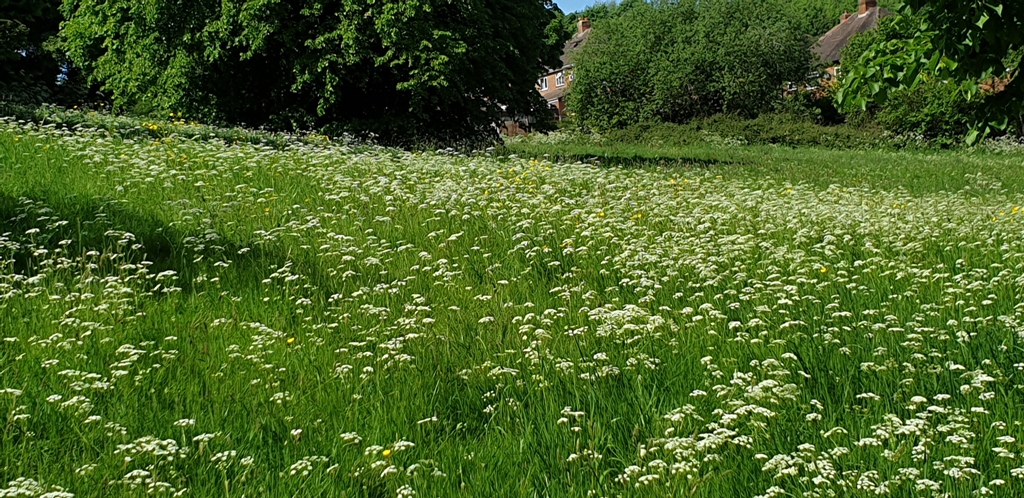
I’ve always liked the Apiaceae or Umbelliferae as they were formerly known as! And everybody knows the carrot so it is also known as the Carrot family.
It is easily recognisable, especially the second subfamily, which are the true ‘Umbels’.
In another post the Ground-elder was fully described for all its useful attributes and this week I hope to tackle all the others in the last family of all the Dicot families in Stace. In another post the Medicinal properties of the Apiaceae are highlighted.
It is a large family with 50 genera and many genera have just the one native species or a few species.
Several of our root vegetables and herbs belong to this family, although these are cultivated forms and the wild species of which they originated are mostly not native (NN in list below) to the British Isles.
I’ve used Wikipedia, PFAF or other websites a lot again as they have such valuable information about the individual species and their uses.
Also links with the online atlas of the British and Irish Flora of the Biological Records Centre in order to find out the natural habitats of the plants.
Medicinal Uses mostly came from the Med Flora by J. Barker as well as from the Plants for a Future website.
Pictures with gratitude by Matt Summers, Mike Poulton and Wikipedia Commons.
FBBC is added behind the Common Name in the contents below if the plant occurs in the ‘Flora of Birmingham and the Black Country’
Contents:
Identifying the Apiaceae or Carrot Family
Subfamily 1: Saniculoideae
Sanicula europaea or Sanicle FBBC
Eryngium maritimum or Sea-holly
Subfamily 2: Apioidea
Chaerophyllum temulum or Rough Chervil FBBC
Anthriscus sylvestris or Cow Parsley, Wild Chervil or Wild Parsley FBBC
- A. caucalis or Bur Chervil FBBC
- A. cerefolium or Garden Chervil
- Scandix pecten-veneris or Shepard’s-needle FBBC
Myrrhis odorata or Sweet Cicely FBBC
- Coriandrum sativum or Coriander FBBC
Smyrnium olusatrum or Alexander FBBC
- Bunium bulbocastanum or Great Pignut
Conopodium majus or Pignut FBBC
Pimpinella saxifraga or Burnet-saxifrage FBBC
- Pimpinella major or Greater Burnet Saxifrage FBBC
Aegopodium podagraria or Ground Elder FBBC
Berula erecta or Lesser Water-parsnip FBBC
Crithmum maritimum or Rock Samphire
Seseli libanotis or Moon Carrot
Oenanthe spp. (7 native) Water-dropworts
- Oenanthe fistulosa or Tubular Water-dropwort FBBC
- O. pimpinelloides or Corky-fruited Water-dropwort FBBC
- O. lachenallii or Parsley Water-dropwort FBBC
- O. silaifolia or Narrow-leaved Water-dropwort
- O. fluviatilis or River Water-dropwort
O. crocata or Hemlock Water-dropwort FBBC
O. aquatica or Fine leaved Water-dropwort FBBC
Aethusa cynapium or Fool’s Parsley FBBC
Foeniculum vulgare var. sativum or Fennel (Arch). FBBC
- Anethum graveolens or Dill FBBC
- Silaum silaus or Pepper-saxifrage FBBC
Meum athamanticum or Spignel
- Physospermum cornubiense or Bladderseed
Conium maculatum or Hemlock FBBC
Bupleurum spp. or Hare’s-ears
- Bupleurum rotundifoliumor Hare’s ear
- B. falcatum or Sickle-leaved Hare’s-ear
- B. tenuissimum or Slender Hare’s-ear
- B. baldense or Small Hare’s ear
- B. subovatum or False Thorow-wax FBBC
- Trinia glauca or Honewort
- Cuminum cymimum
Apium graveolens or Wild Celery FBBC
- Helosciadium repens or Creeping Marshwort
- H. nodiflorum or Fool’s -water-cress FBBC
- H. inundatum or Lesser Marshwort FBBC
- Trachyspermum ammi or Ajowan
- Ridolfia segetum or False Fennel
Sison segetum or Corn Parsley
- Sison amomum or Stone Parsley FBBC
- Cicuta virosa or Cowbane
- Ammi majus or Bullwort FBBC
- Visnaga daucoides or Toothpick-plant FBBC
- Falcaria vulgaris or Longleaf
Carum carvi or Caraway FBBC
- Carum verticillatum or Whorled caraway
- Selinum carvifolia or Cambridge Milk-parsley
Ligusticum scoticum or Scots Lovage
- Levisticum officinale or Lovage FBBC
Angelica sylvestris or Wild Angelica FBBC
- Angelica archangelica or Garden Angelica or Archangelica FBBC
- Ferula communis or Giant Fennel
Peucedanum officinale or Hog’s Fennel
- Imperatoria ostruthium or Masterwort & Imperatoria
- Thysselinum palustre or Milk-parsley
Pastinaca sativa ssp. sylvestris or Wild Parsnip FBBC
Heracleum spondylium or Hogweed or Cow parsnip FBBC
Torilis spp. or Hedge-parsleys
- Torilis japonica or Upright Hedge Parsley FBBC
- T. nodosa or Knotted Hedge Parsley
Daucus carota ssp. carota or Wild Carrot FBBC
Petroselinum crispum or Garden Parsley FBBC
Anthriscus cerefolium or Garden Chervil
Identifying the Apiaceae or Carrot Family:
With a bit of practice or using the keys in either ‘The New Flora of the British Isles’ by Clive Stace or ‘The Wild Flower Key’ by Francis Rose, it is not difficult to identify them in the field. It is easier if you can find some ripe fruit and look through a magnifying glass, as these are one of their main diagnostic features.
Some are poisonous (pink background colour!) and as many genera can look a bit similar, you must be very sure, before you use any as food or medicine!
Now for the more scientific stuff:
This family is split into 2 subfamilies and the first subfamily; called
Subfamily Saniculoideae
At first glance these don’t look like Umbels.
It has got 3 genera of which the first and third genera have a native species.
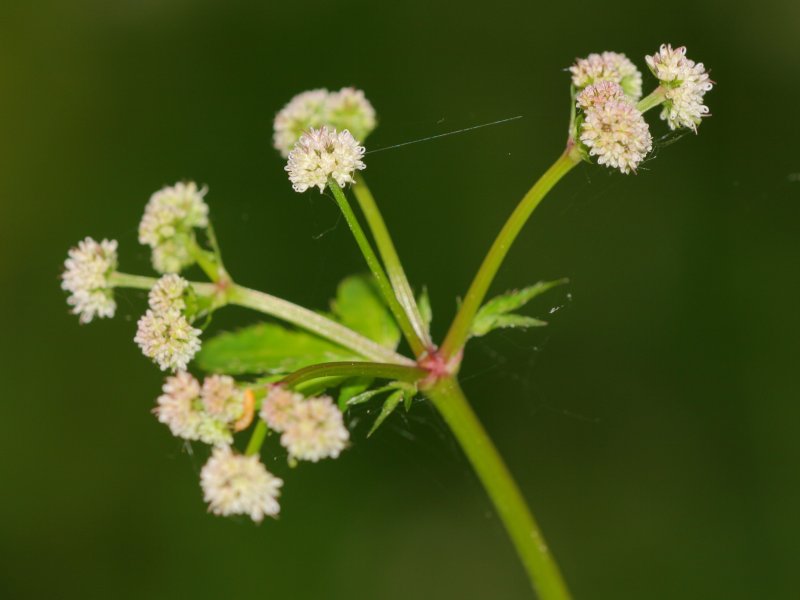
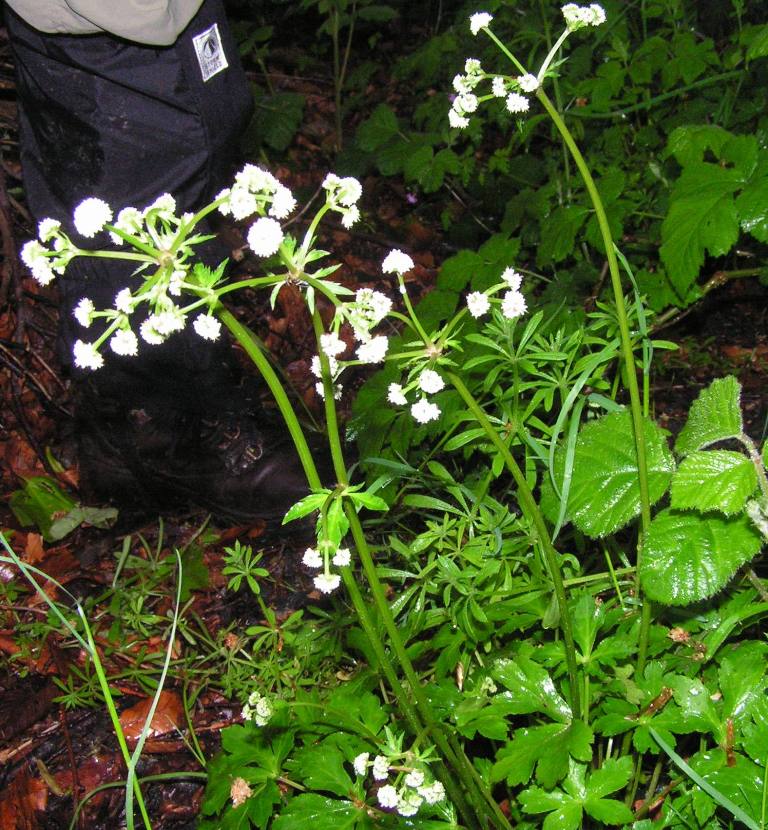
Sanicula europaea or Sanicle
This is a perennial herb of moist soil in deciduous woodland, often where Fagus, Fraxinus or Quercus spp. predominate.
The name comes from the Latin ‘to heal’ and ‘healthy’. It was a plant valued by the School of Salerno and throughout the Middle Ages and beyond. It is not much used in modern medicine.
Uses: Gastro-enteritis, especially with suspected ulceration or occoult bleeding. Flatulence. Diarrhoea. Respiratory and urinary infections. Leucorrhoea. Metritis and menorrhagia (In the past was fed to cows after calving to aid expulsion of afterbirth and to stop bleeding) Externally: for healing varicose and other ulcers, haemorrhoids, bruises, chilblains, skin rashes. As a mouthwash for sore gums, etc. or sore throat (gargle)
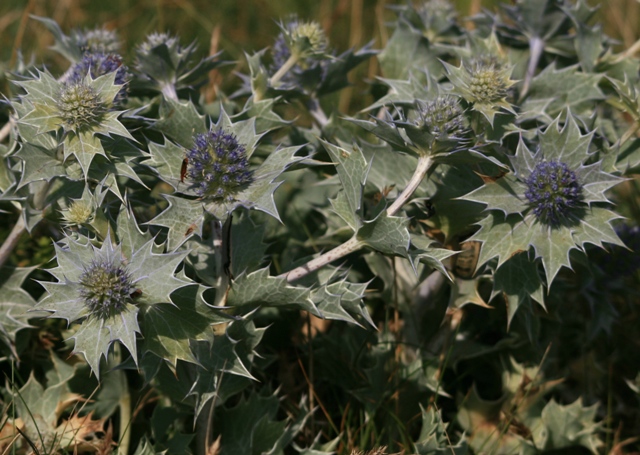
Eryngium maritimum or Sea-holly
A glaucous, spiny-leaved perennial herb confined to coastal habitats, occurring mainly on incipient and mobile sand dunes and occasionally on shingle; often a little above high-tide mark.
It has an interesting history as an aphrodisiac.
Uses: Cystitis, urethritis, urinary calculus; renal colic; haematuria. Benign prostatic hypertrophy. Prostatitis.
Subfamily Apioidea
There are 47 different genera in the subfamily Apioidea or the true umbels.
The whole plant is attractive in my opinion. The foliage can be very delicate and sometimes the first greenery can be witnessed in late winter. Then the flowering umbels themselves are like lace, providing food to many insects and later when all foil has gone is a statuesque reminder of what has been.
I will list below all the natives, neophytes or archeophytes and occasional non natives (NN) below (from Stace) with their scientific (always in italic, which is the rule in nomenclature) as well as one or more common names.
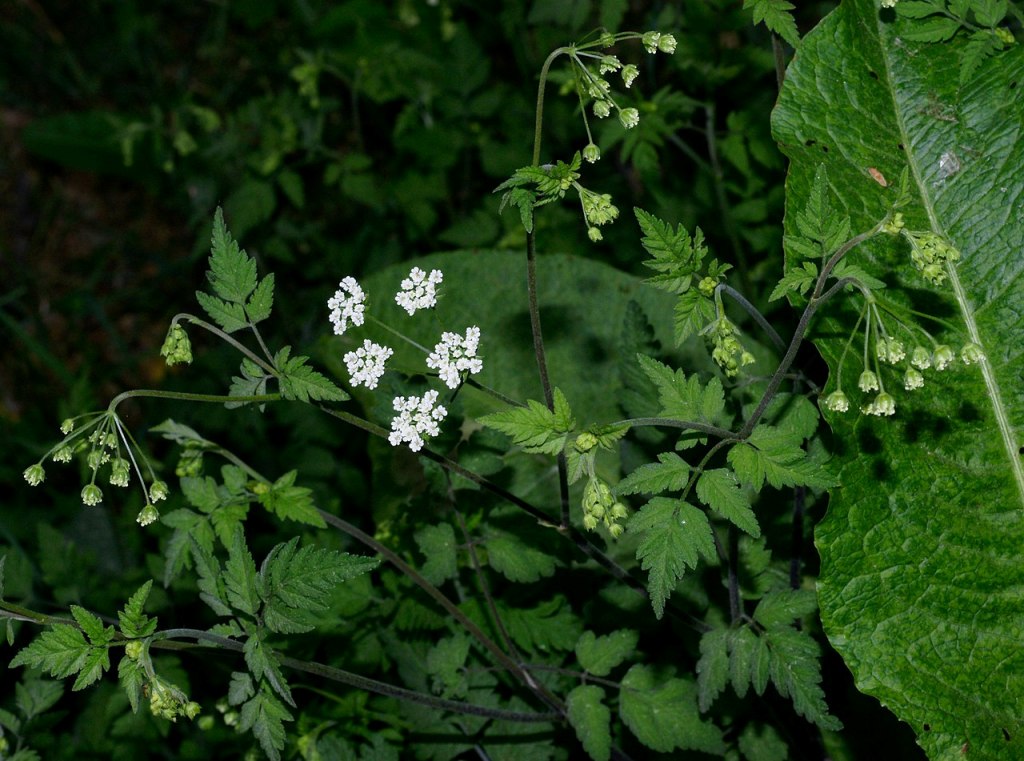
Chaerophyllum temulum or Rough Chervil
A native biennial herb, especially characteristic of rank grassland on roadside verges, by hedges and along wood-borders and forest rides; also found on railway banks and in waste places.
It contains (mainly in the upper parts and fruits) a volatile alkaloid chaerophylline, as well as other (probably glycosidally bound) toxins, the chemistry and pharmacology of which has, as yet, been but little studied.
Chaerophyllum temulum has been used in folk medicine, in small doses, to treat arthritis, dropsy, and chronic skin complaints, and as a spring tonic.
Pollen is collected by solitary bees.
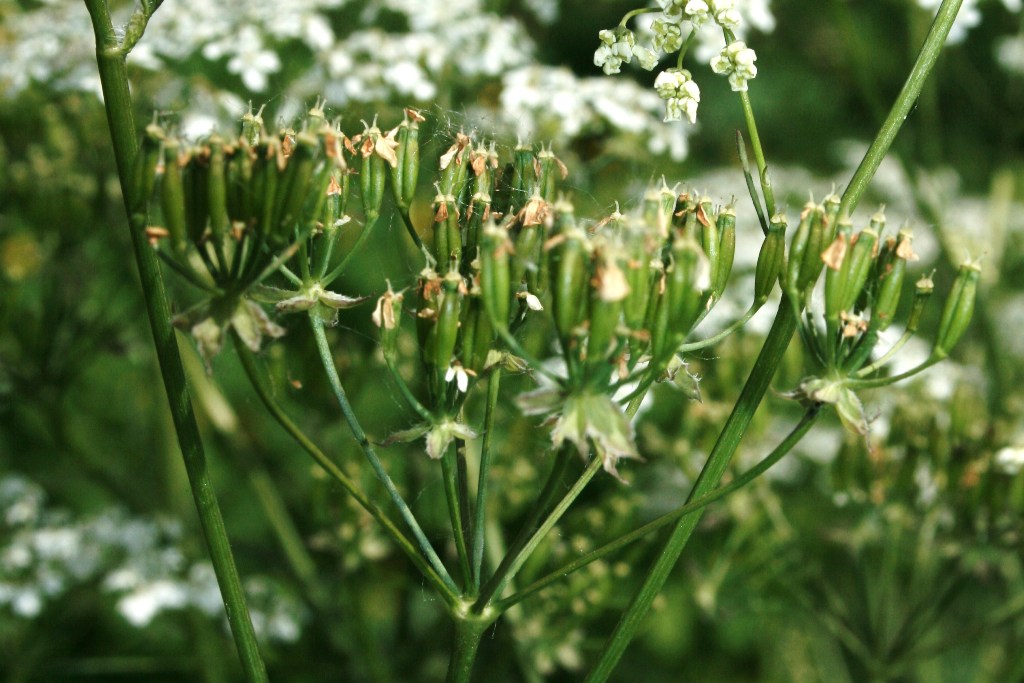
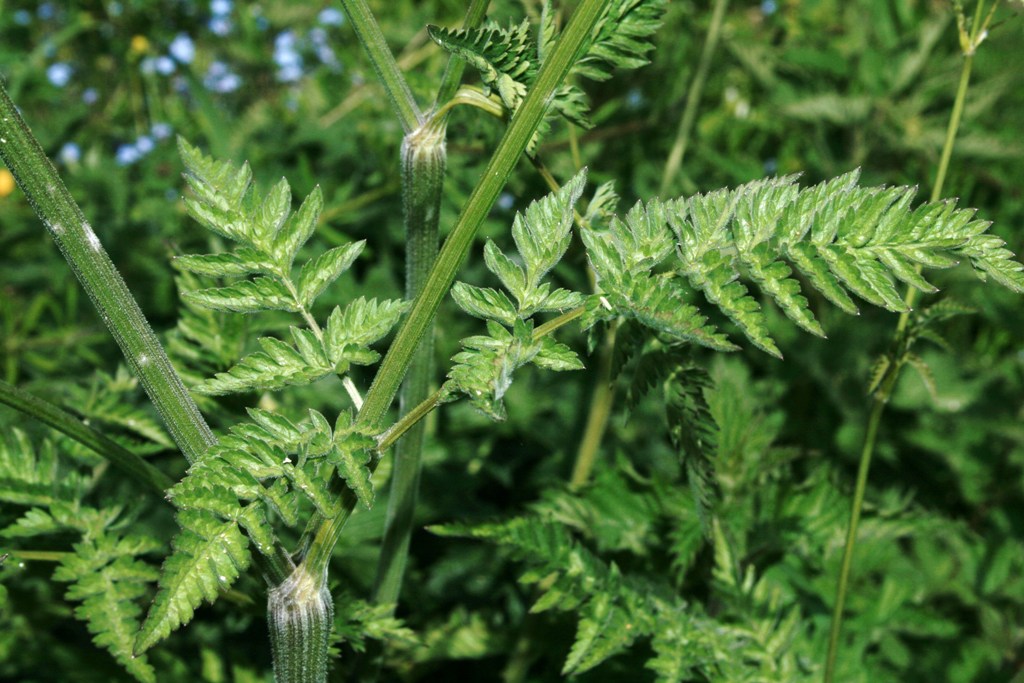
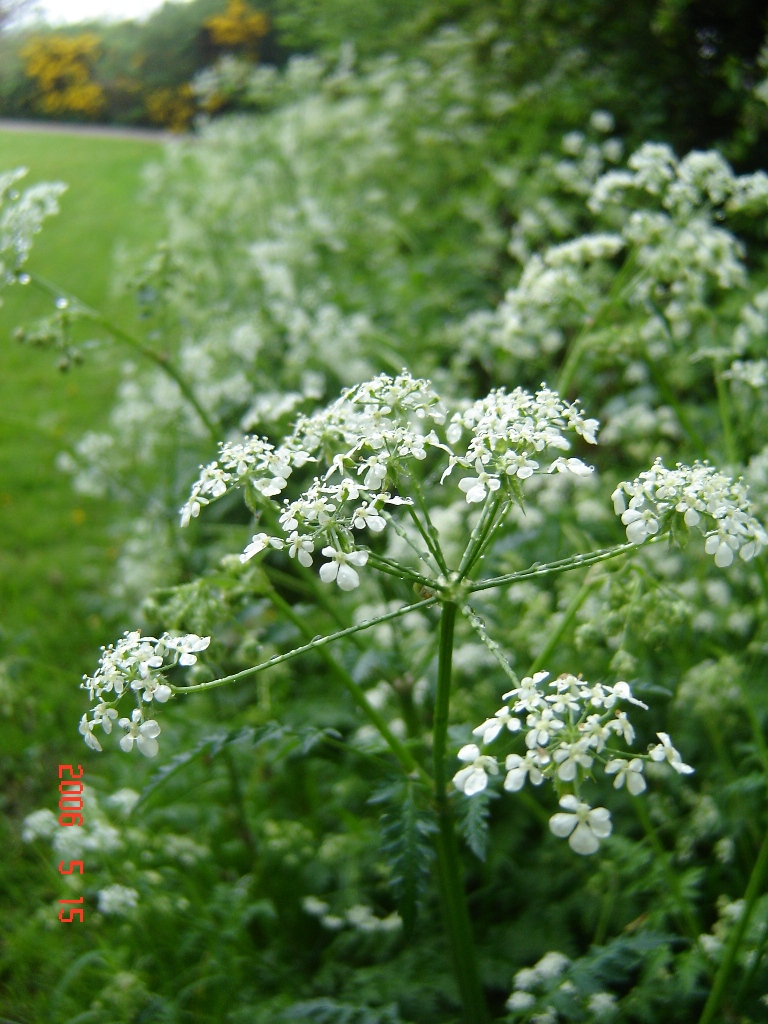
Anthriscus sylvestris or Cow Parsley, Wild Chervil or Wild Parsley.
A very common and robust perennial herb, characteristic of roadsides and hedgerows, but also occurring in abandoned pastures and under-managed hay meadows, in woodland rides and edges, on railway banks, and on waste and cultivated ground.
This should be picked as soon as you can identify it properly. Later in the year it will get too bitter. It dries well! Good for salads, part. Cold potato, tomato, and cucumber. Flavouring for hot haricot beans, and herb omelettes. Don’t pick along roads (car-fumes!)
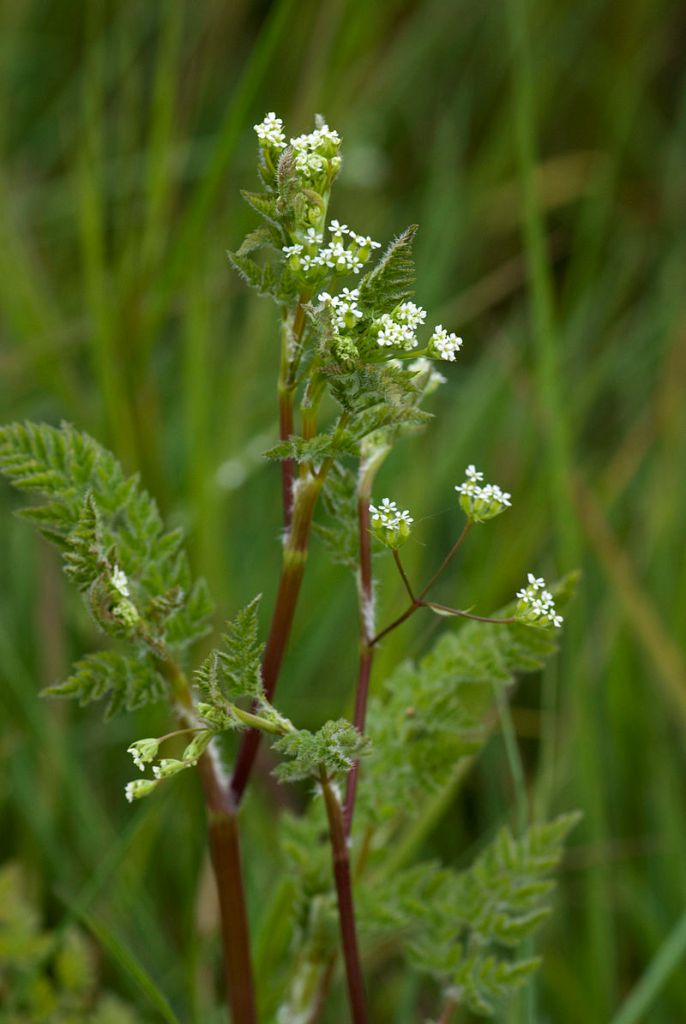
Anthriscus caucalis or Bur Chervil
An annual herb of open habitats on well-drained, mainly sandy or gravelly soils, including dry grassland, hedgebanks, roadsides, sea-walls, waste ground, gravel-pits, arable fields and as a street weed.
- Anthriscus cerefolium or Garden Chervil
See at the bottom of this post!
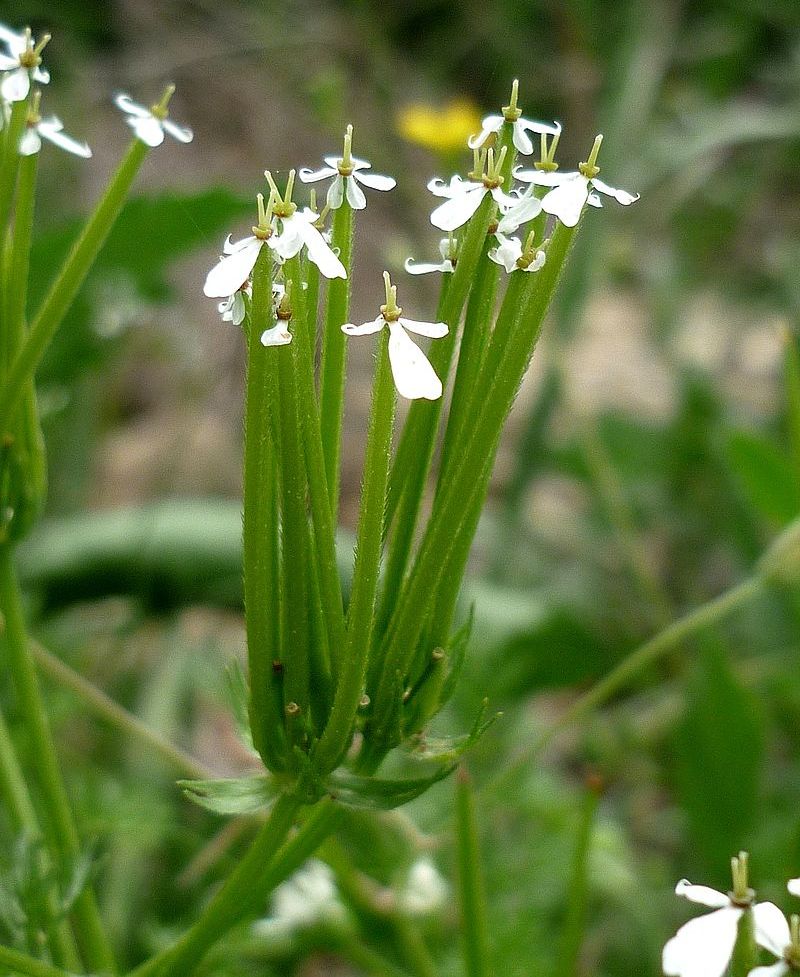
Scandix pecten-veneris or Shepard’s-needle
An archaeophyte and annual of arable fields, particularly on calcareous clay soils.
This is a salad-herb. It is aperitif and stomachic, also said to be aphrodisiac. The upper leaves are used and not the elongated fruit.

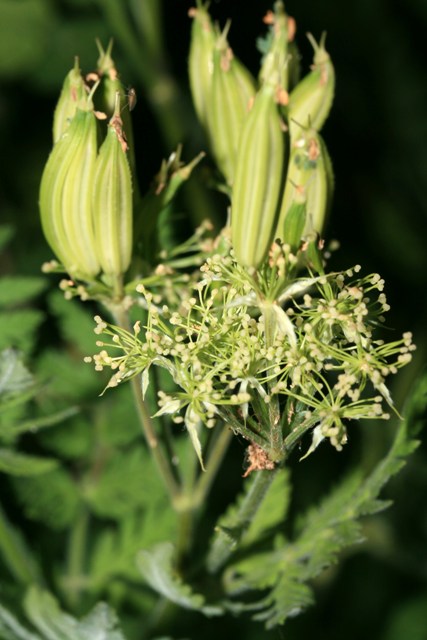
Myrrhis odorata or Sweet Cicely
A neophyte perennial herb of hedge banks, woodland margins, roadside verges, river banks and other grassy places., often close to houses or old settlements, indicating its origin in cultivation. It spreads by seed and is often dispersed over large distances along streams and rivers.
This beautiful plant has featherly leaves which have a distinctly sugary overtone to their mild aniseed flavour and are ideal for flavouring stewed fruits such as gooseberries and plums. Some experimenters have been able to halve the amount of sugar they would normally use for such dishes by the plentiful addition of the herb. The fruits make tasty snacks!
It is also a very handsome plant to grow in your garden. The leaves have white blotches, which makes an attreactive pattern. The flowers are an attractive bonus to the foliage.
Gerard was much in favour of sweet cicely!
Sweet cicely is a herbal tonic that restores energy, lifts the spirats and settles the digestion. The fruits or leaves and stems can be made into an aperitif against poor appetite, weak digestion, flatulence and indigestion. It is a good remedy for older people who have lost their enthusiasm for life, as it lifts the spirits and enkindles the digestive fire. It enables them to enjoy their food with good appetite, warming the digestion and improving absorption of nutrients. This plant is also beneficial for anyone who is weak or exhausted, perhaps after a chronic illness or caring for someone else. It will help them get back their energy and joie de vivre, slowly rebuilding their strength and gently warming the whole system. (from Hedgerow Medicine)
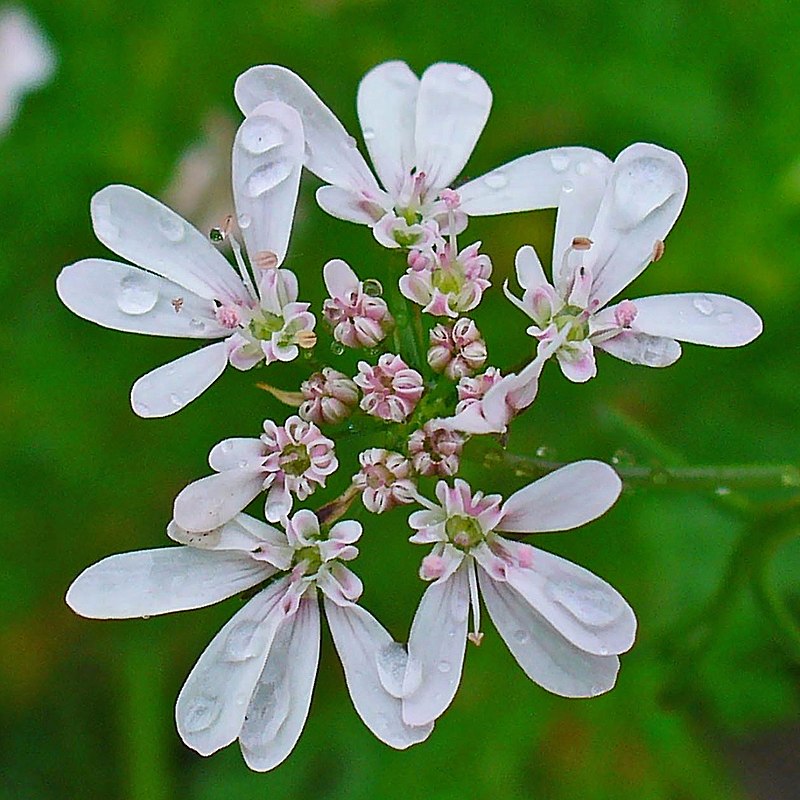

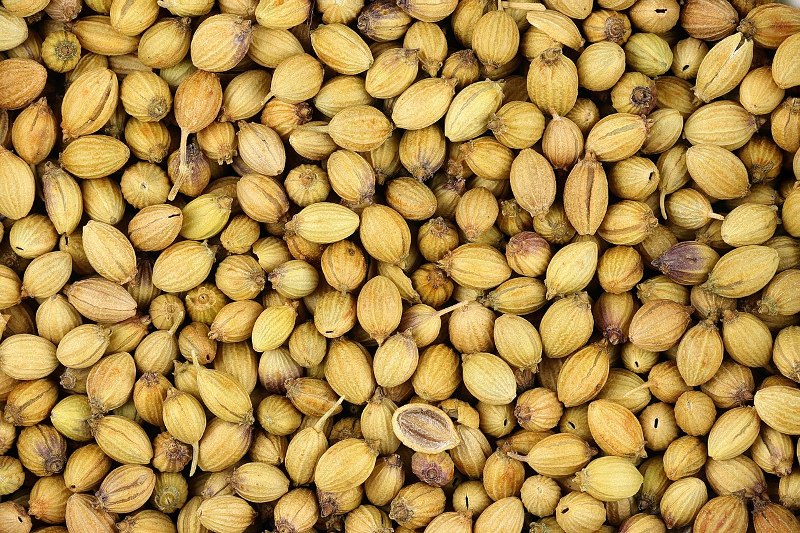
Coriandrum sativum or Coriander (NN)
Often grown and seen on our allotment site!
Leaves used raw or cooked as a flavouring in salads, soups etc and seeds in cakes, bread and curries. The fresh leaves are probably the most widely used flavouring herb in the world.
Both leaves and fruits are useful against flatulence and colic and may be given to children and babies over 6 months old.


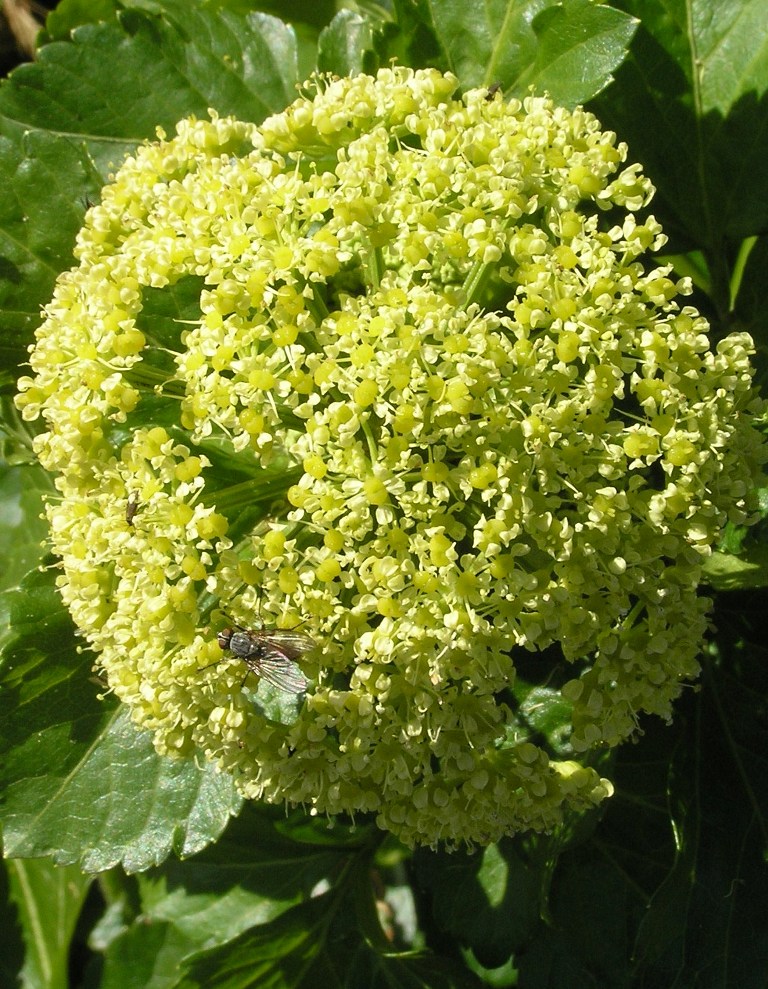
Smyrnium olusatrum or Alexander
An archaeophyte and a robust perennial herb naturalised in hedge banks, on cliffs, at the base of walls, and on grassy roadsides, pathsides and waste ground, mainly near the sea. Lowland.
The Romans brought alexanders to this country from the Mediterranean, as a pot-herb. It thrived, became naturalised, and was still being planted in kitchen gardens in the early eighteenth century. Most parts of the plant have been used in the kitchen at one time or another. A seventeenth century botanists described a soup made of the upper part of the roots. The flower buds were used in medieval salads. And the young leaves make a spicy addition to modern green salads. The most succulent part of the plant is the lower blanched stem. Cook these stems in boiling water for not more than ten minutes. Then eat them like asparagus, with molten butter. They have a wonderfully delicate texture, and a pleasantly aromatic taste.
Bunium bulbocastanum or Great Pignut
A tuberous perennial herb of dry chalk soils, most frequent in arable fields, especially where cultivation has ceased, and sometimes dominant in arable reverting to pasture.
The small, rounded taproot is edible raw or cooked, and said to taste like sweet chestnuts. The leaf can be used as an herb or garnish similar to parsley.
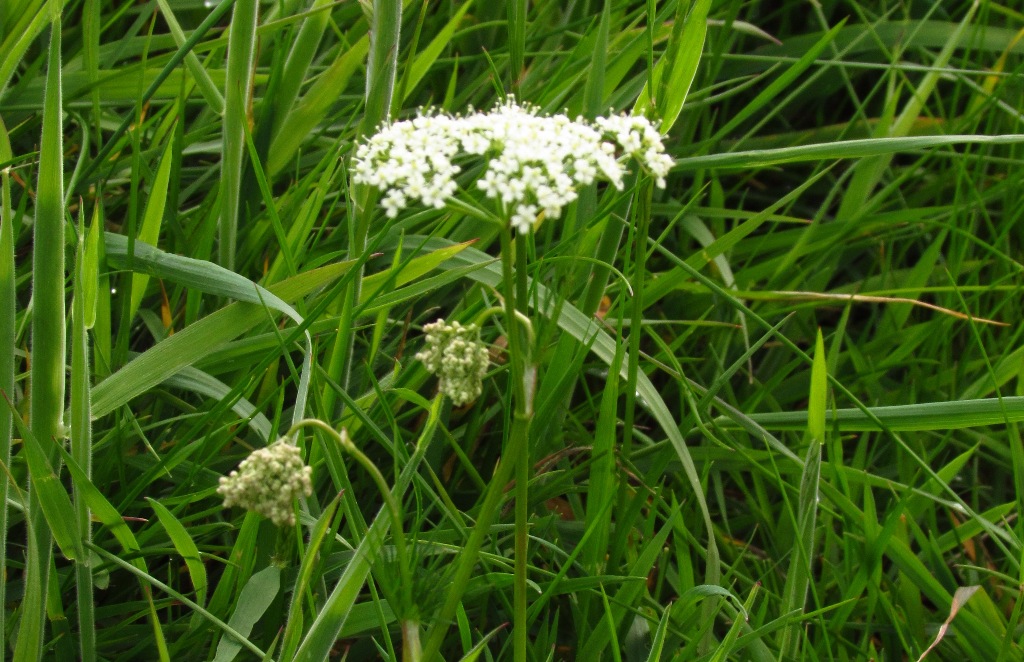
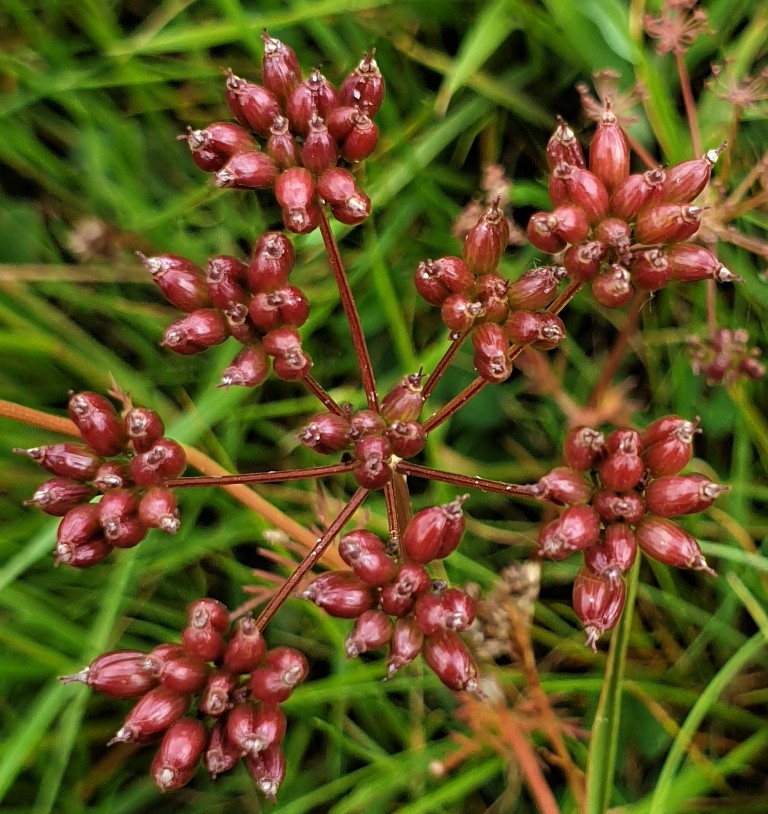
Conopodium majus or Pignut
A perennial herb, found in damp or shaded meadows and pastures, hedgerows, roadside verges, copses and woodlands; especially characteristic of some types of northern hay meadow (Rodwell, 1992).
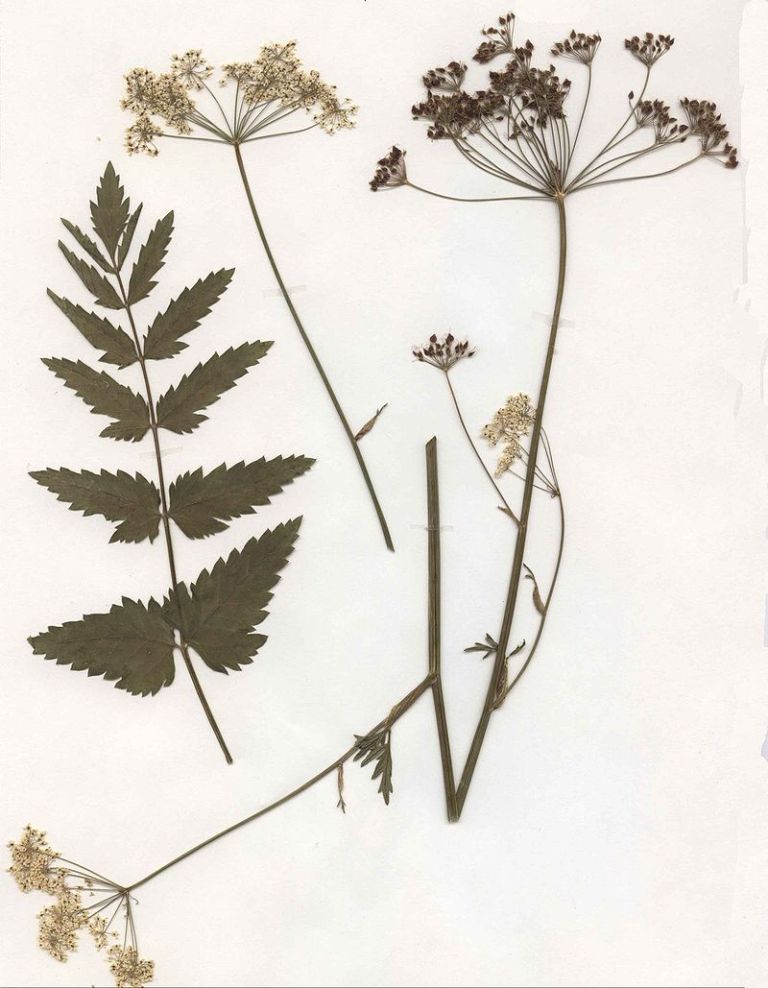
A herbarium sheet showing Pimpinella major or Greater Burnet Saxifrage (Wikipedia Commons)
Pimpinella major or Greater Burnet Saxifrage
A perennial herb, mainly on basic soils derived from chalk and limestone, but also on clay, and most often found on roadsides, hedge banks, railway banks and wood edges, sometimes persisting on roadsides when neighbouring woods have been removed and very occasionally spreading on verges where any woods were felled centuries ago, as in Fenland.
It is highly nutritious for sheep and cattle, and in the past was cultivated on calcareous soils for fodder.
John Gerard‘s Herball (1597) commends the plant’s properties, and states that it is: “A speciall helpe to defend the heart from noysome vapours and from the infection of the Plague or Pestilence, and all other contagious diseases for which purpose it is of great effect, the juice thereof being taken in some drink…it is a capital wound herb for all sorts of wounds, both of the head and body, either inward or outward, used either in juice or decoction of the herb, or by the powder of the herb or root…”
Uses: Sore throat, laryngitis, flatulent dyspepsia. Catarrh associated with upper respiratory tract infections. Said to be useful for asthma. Gargle- internal usage is uncertain so only use small doses for limited period.
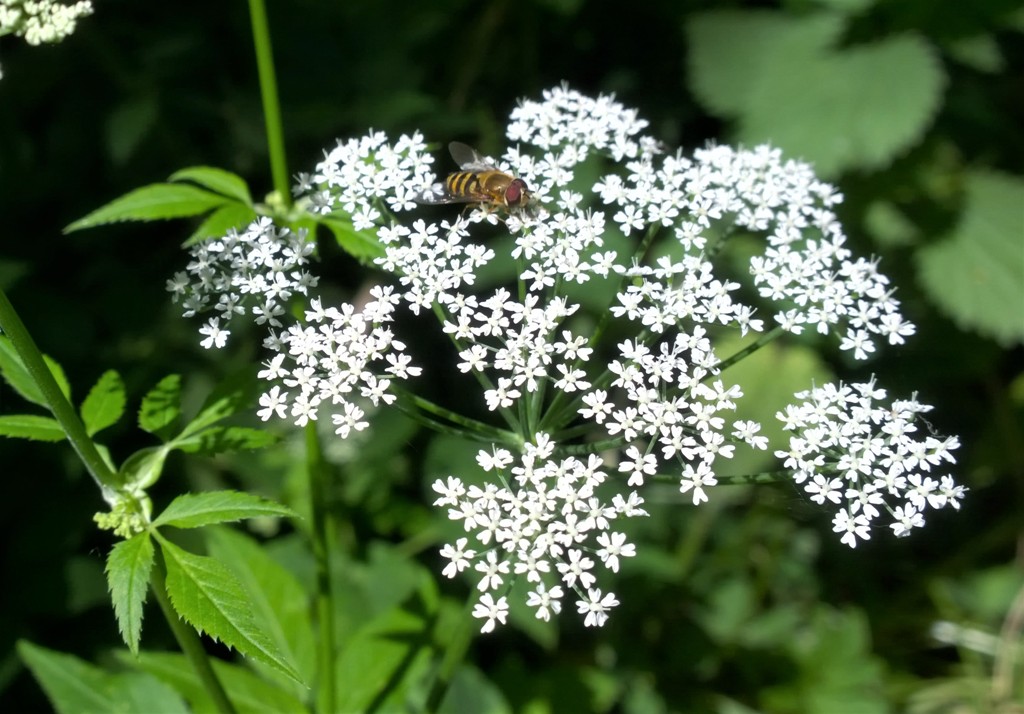
Aegopodium podagraria or Ground Elder
See my previous post all about this important plant!
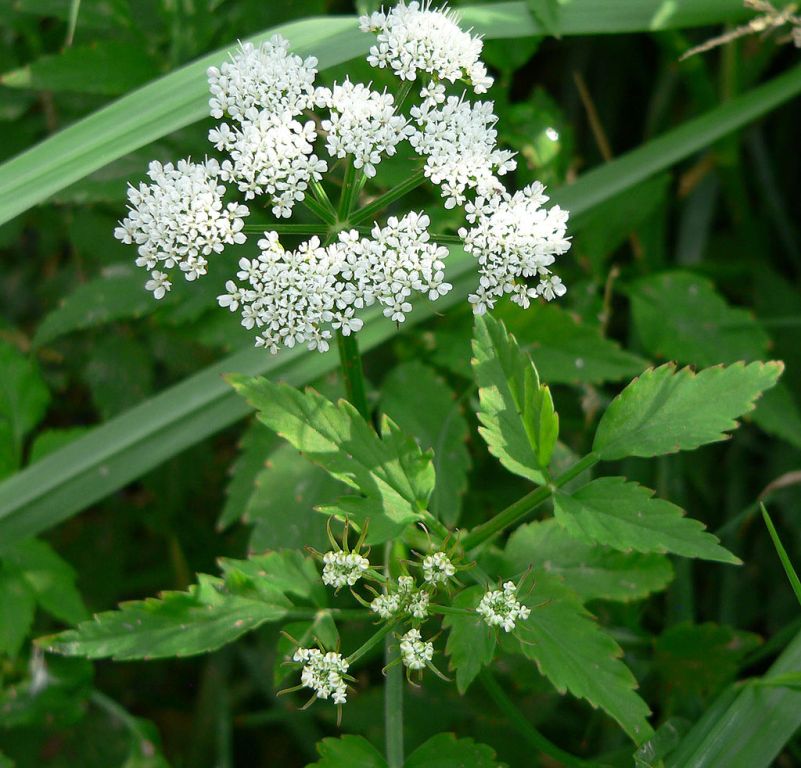
Berula erecta or Lesser Water-parsnip
This stoloniferous perennial occurs as a submerged aquatic in rivers and streams, and as an emergent species at the edges of lakes, ponds, rivers, ditches and canals, and in marshes.
The plant’s essential oil has been shown to contain polyacetylenes. Polyacetylenes have a wide range of beneficial medicinal effects. One is its nematodicidal effects that could potentially be beneficial in agriculture as well its positive effects on human health.
Polyacetylenes also are antifungal, antibacterial, and have antiallergenic and anti-inflammatory properties.
Warning:
Medicinal use of pure polyacetylenes is not feasible due to their high chemical instability as well as a tendency to evoke allergic reactions. For this reason, consuming smaller and less pure amounts of polyacetylenes from the essential oil of Berula erecta may be viable.
- The Zuni people use Berula erecta as an ingredient of “schumaakwe cakes” and used it externally for rheumatism.
- An infusion of the whole plant is used as wash for rashes and athlete’s foot infection.
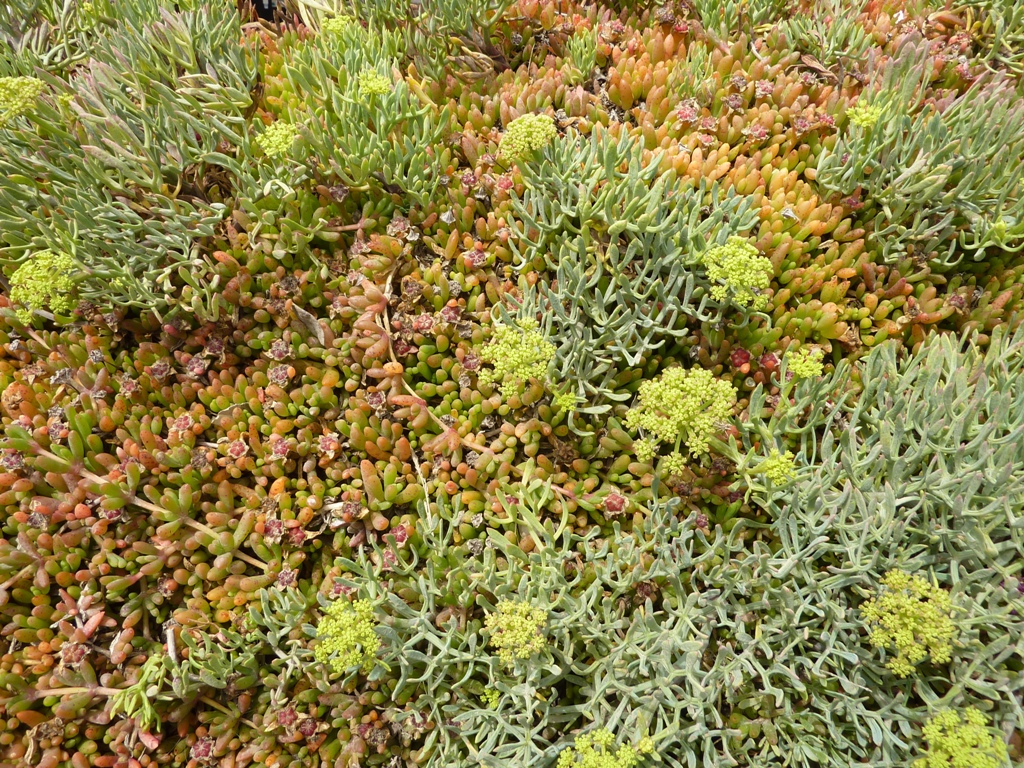
Crithmum maritimum or Rock Samphire.
A fleshy perennial herb of spray-drenched rock crevices and ledges on sea-cliffs, coastal rocks and on stabilised shingle; also in maritime grassland and artificial habitats like harbour walls and stone sea defences.
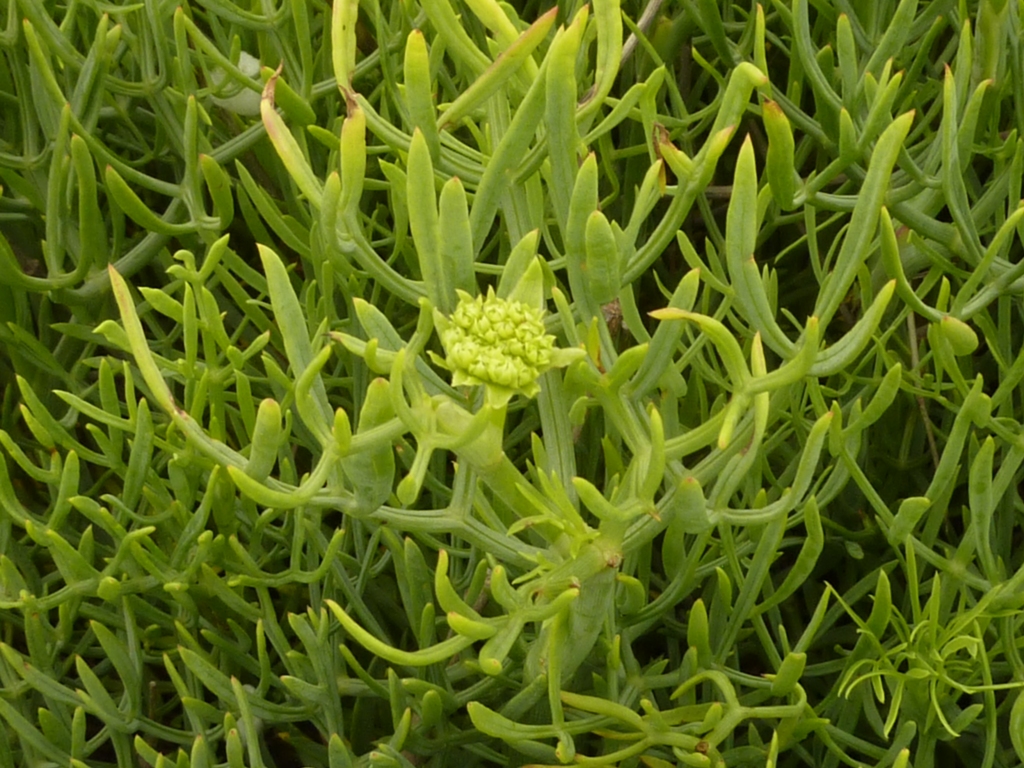
This is frequent on rocky coasts in the south and west. Both leaves and stems are used for boiling. Boil for 15 minutes and serve with melted butter. Also known as a pickle. It was John Evelyn’s favourite vegetable! Has got much Vitamin C.

Seseli libanotis (syn. Libanotis montana) (from book ‘Deutschlands Flora in Abbildungen’. By Johann Georg Sturm (Painter: Jacob Sturm) Wikipedia Commons.
Seseli libanotis or Moon Carrot
This herb is usually biennial, though it is sometimes a short-lived monocarpic perennial.
- The leaves and root are edible.
- S. libanotis is useful in honey production
Used in folk medicine. Several studies suggest that S. libanotis and other members of Seseli have natural antimicrobial and antioxidant properties
Oenanthe spp. (7 native) Water-dropworts:
for more information see the links and below for just 2 most common species.
- O. fistulosa or Tubular Water-dropwort FBBC
- O. pimpinelloides or Corky-fruited Water-dropwort FBBC
- O. lachenallii or Parsley Water-dropwort FBBC
- Oenanthe silaifolia or Narrow-leaved Water-dropwort
- Oenanthe fluviatilis or River Water-dropwort
- Oenanthe crocata or Hemlock Water-dropwort FBBC
- Oenanthe aquatica or Fine leaved Water-dropwort FBBC
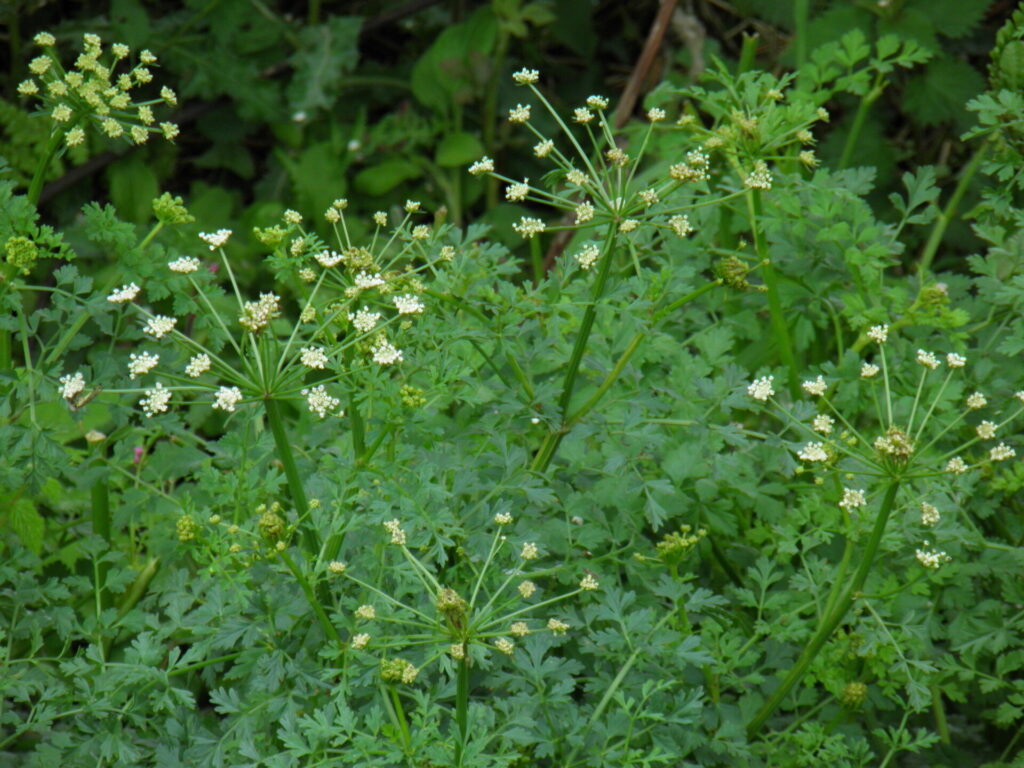
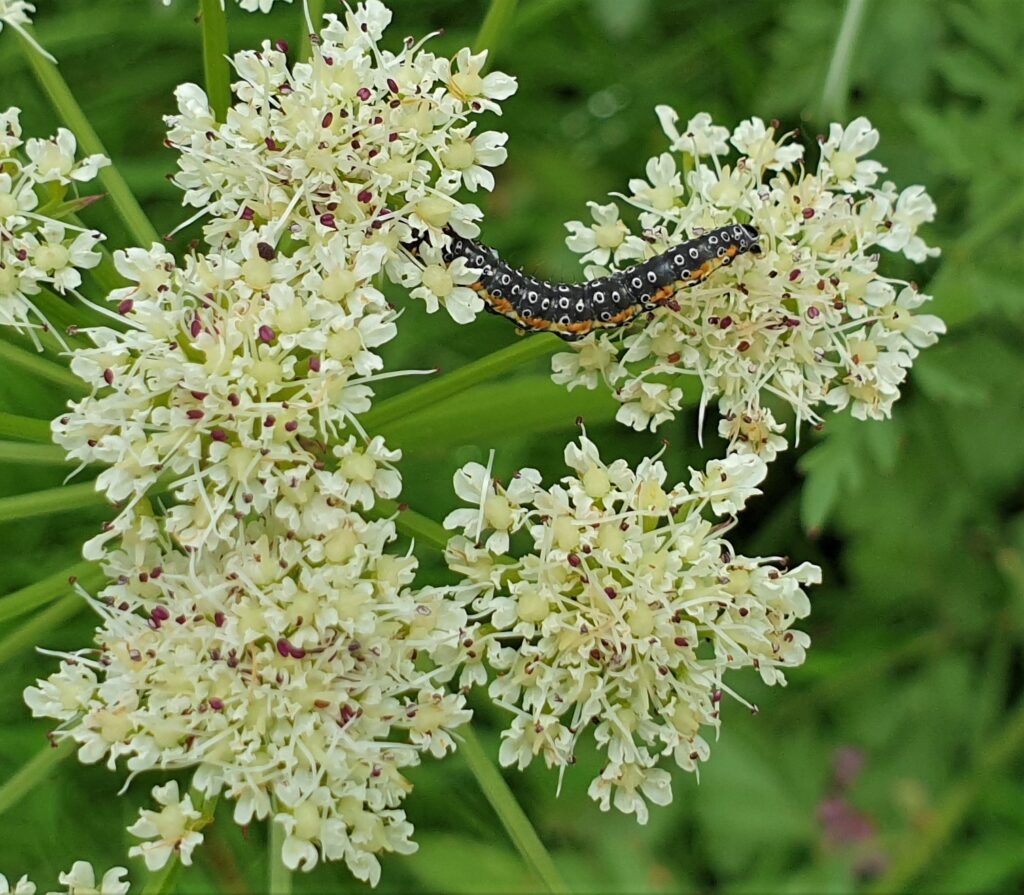
Oenanthe crocata or Hemlock Water-dropwort
A tuberous perennial herb of shallow water in ditches, the banks of streams, rivers, canals, lakes and ponds, roadside culverts, marshes and wet woodland, among boulders at the top of beaches and on dripping or flushed sea-cliffs.
It has been used externally for warts and whitlows. Mrs Grieve says it has been taken for eruptive conditions of the skin. It would have to be a serious eruption recalcitrant to other treatment before one would conceive of administering so poisonous a plant.
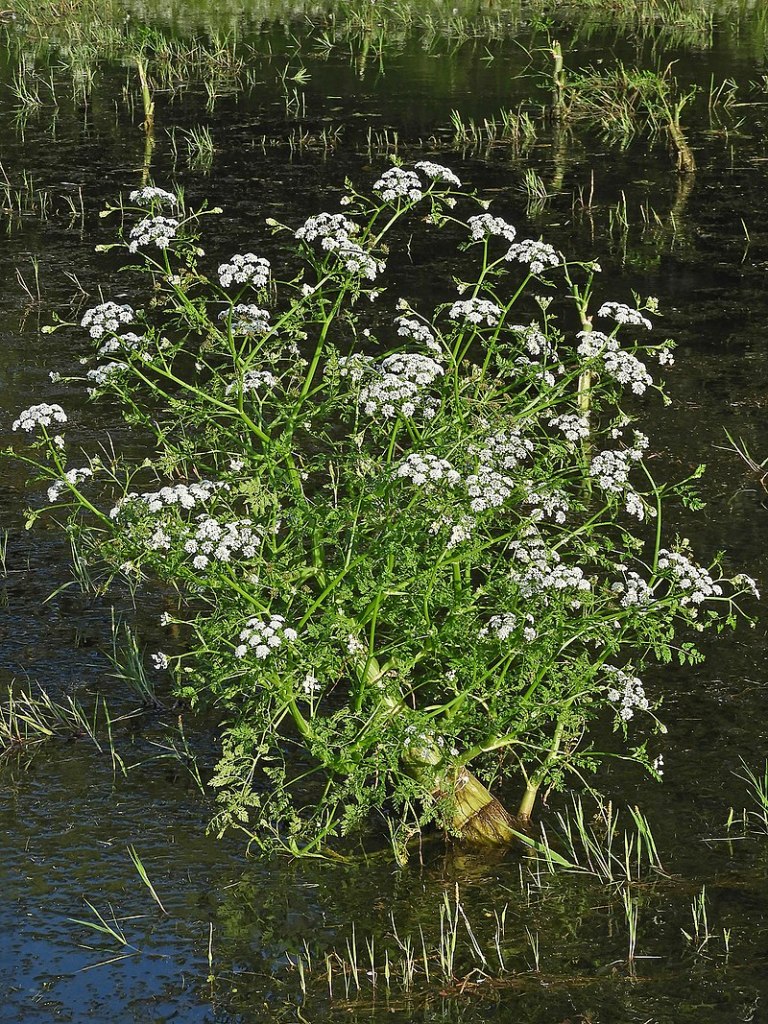
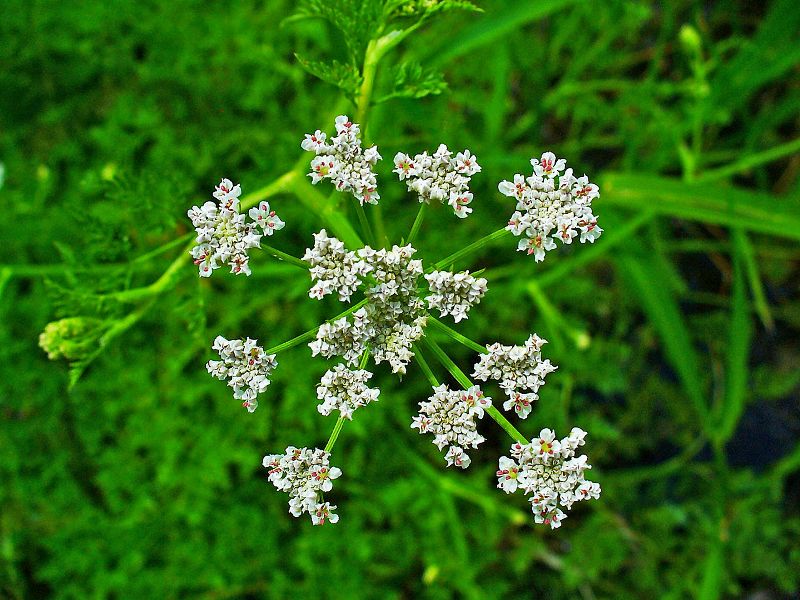
Oenanthe aquatica or Fine leaved Water-dropwort
A tuberous perennial herb of still or slow-moving water, usually occurring on deep, silty, often eutrophic, substrates in shallow ponds and ditches, often where water fluctuates in depth.
It is a poisonous plant! In overdose the fruits cause vertigo, intoxication and other narcotic effects.
It is used in the treatment of chronic pectoral affections, dyspepsia, intermittent fevers, obstinate ulcers etc.
Aethusa cynapium or Fool’s Parsley.
An annual of hedge banks, waste places, arable fields and other cultivated ground.
This can be mistaken for Garden Parsley but is poisonous!
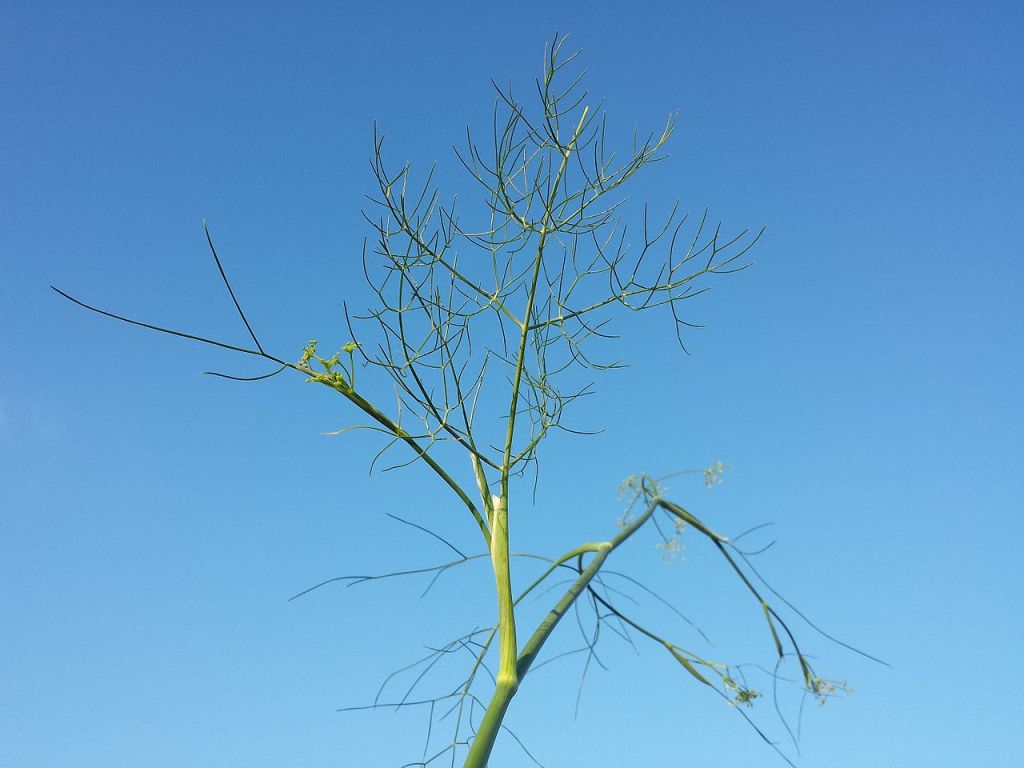
Foeniculum vulgare var. sativum or Fennel (Arch).
A perennial herb found in marshes, on sea-walls, in gravel-pits, on roadsides and waste ground and on rubbish tips.
The whole plant is edible and have a fresh , nutty flavour. Seeds gathered late in October have a strong smell dried. Fennel was one of the Anglo-Saxon herbalists’ nine sacred herbs, and later writers credit it with astonishingly versatile powers: (The Englishman’s Doctor, 160B)
Action: Aromatic and carminative aperitif and metabolic aid. Diuretic. Galactagogue. Antimicrobial Uses: Dyspepsia; flatulent colic in children. Topically: Blepharitis, conjunctivitis (compresses made from strong infusion).
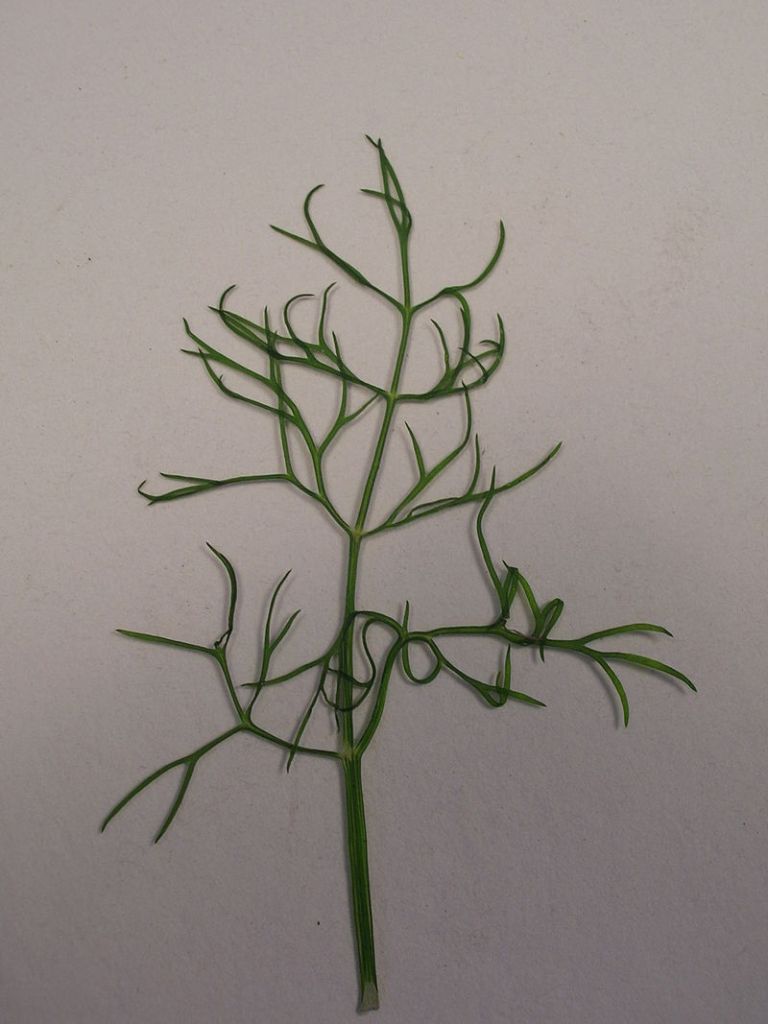
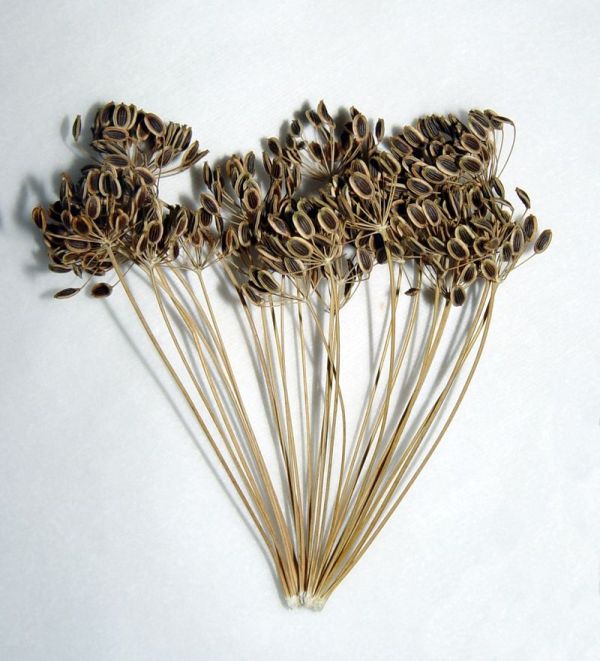
Anethum graveolens or Dill (Neophyte)
An aromatic annual thriving on light, well-drained soils, occurring as a casual in habitats associated with man, including in and near gardens, waste places and rubbish dumps. Also mentioned as a bird seed or grain-alien.
Used to flavour many foods such as gravlax (cured salmon) and other fish dishes, borscht, and other soups, as well as pickles (where the dill flower is sometimes used).
The oil from the seeds is distilled and used in the manufacturing of soaps.
Silaum silaus or Pepper-saxifrage
S. silaus is found in damp, unimproved neutral grassland, usually on clay soils.
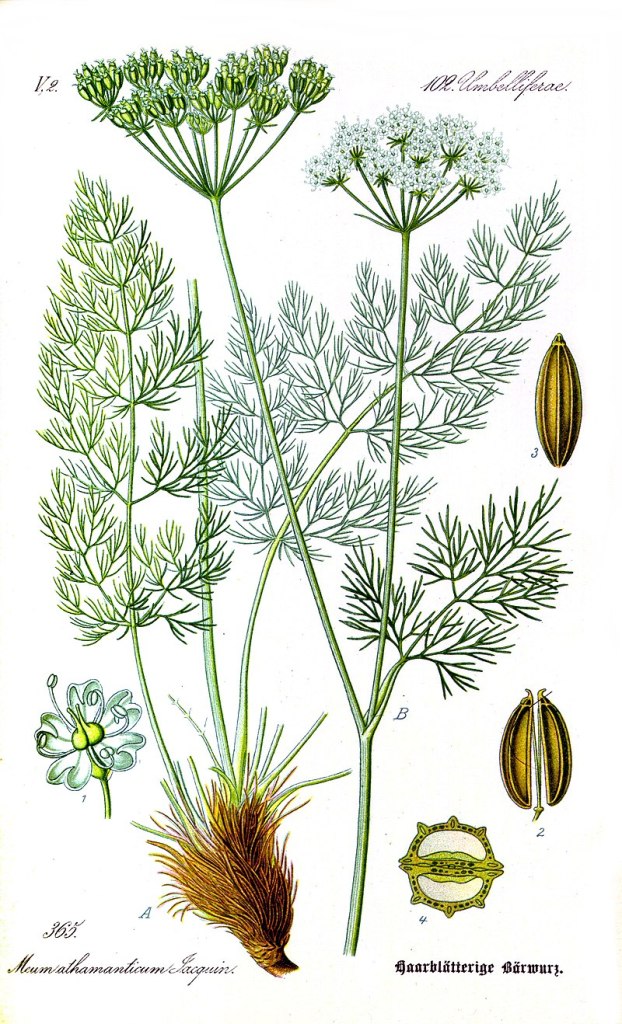
Illustration of Meum athamanthecum: By Dr. Otto Wilhelm Thomé – Flora von Deutschland Österreich und der Schweiz (1885) in Wikipedia
Meum athamanticum Meum or Spignel
A perennial herb of deep brown-earth neutral or mildly acidic soils occurring in dry, unimproved grassland in pastures, hay meadows and on roadside-banks
It has interesting uses in the past both as a food and medicinal! Meum has been cultivated in Scotland, where the roots were eaten as a root vegetable.
Physospermum cornubiense or Bladderseed
This rhizomatous perennial herb is often found in substantial, loose colonies in open woodland, in Ulex scrub on heaths, on rough grassy slopes (often in stream valleys), in Molinia grassland, and on shaded roadside banks.
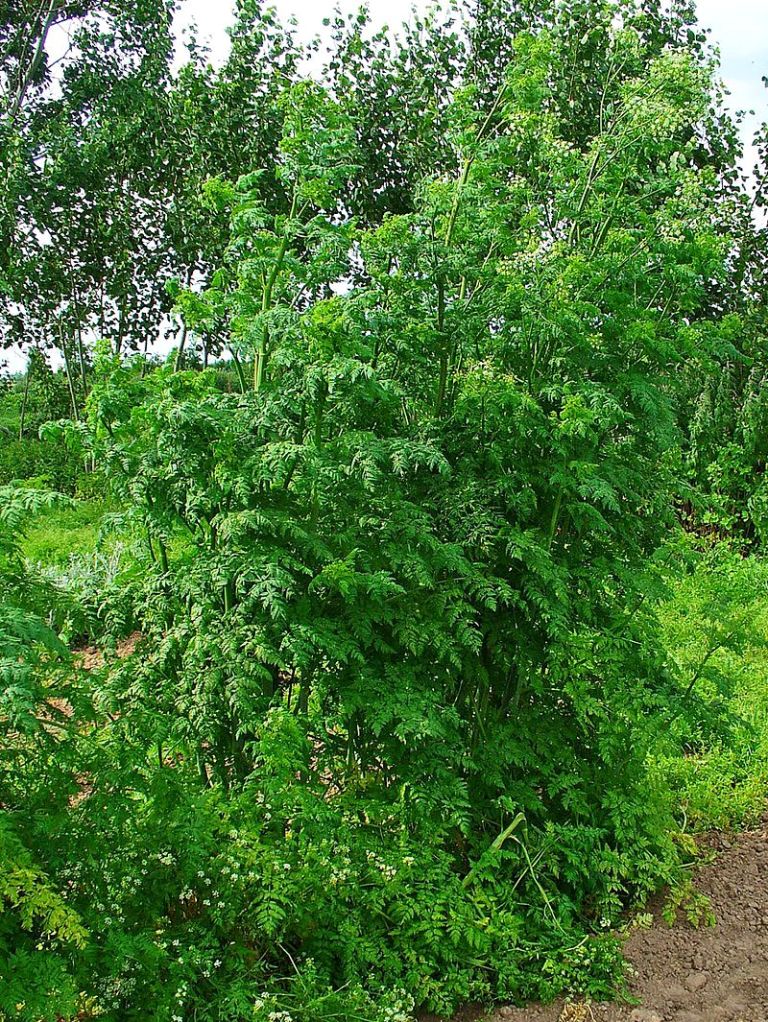
Conium maculatum or Hemlock
A very tall, biennial, winter-green herb of damp places, such as ditches and river banks, and of drier habitats, including rough grassland, waste ground, rubbish tips and roadsides.
All parts of the plant are toxic, especially the seeds and roots, and especially when ingested. Under the right conditions the plant grows quite rapidly during the growing season and can reach heights of 2.4 metres (8 feet), with a long penetrating root.
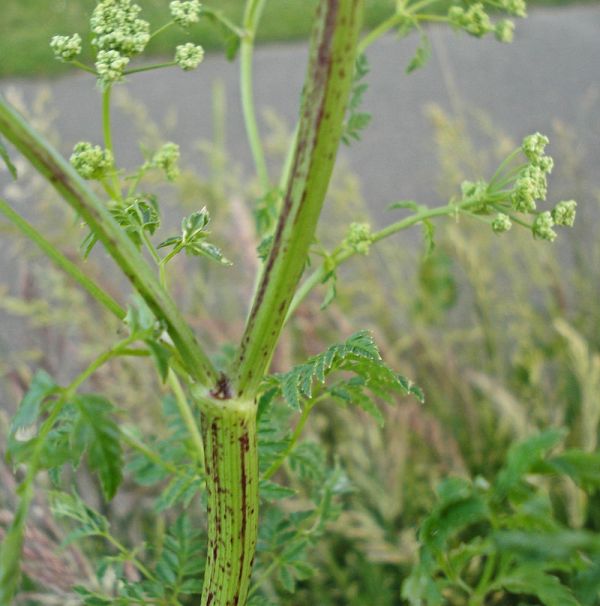
The plant has a distinctive odour usually considered unpleasant that carries with the wind. The hollow stems are usually spotted with a dark maroon colour before the plant dies and becomes dry and brown after completing its biennial lifecycle. The hollow stems of this toxic plant are deadly for up to 3 years after the plant has died.
Hemlock has a long history of medicinal use, though as it is very poisenous it is very rarely used in modern herbalism.
“If Hemlock has made the name of Socrates widely known, then the death of Socrates has made the reputation of Hemlock”. Much used in past and not just for poison. Actions: Analgesic, antineuralgic, antispasmodic; anaphrodisiac.
Bupleurum spp. or Hare’s-ears
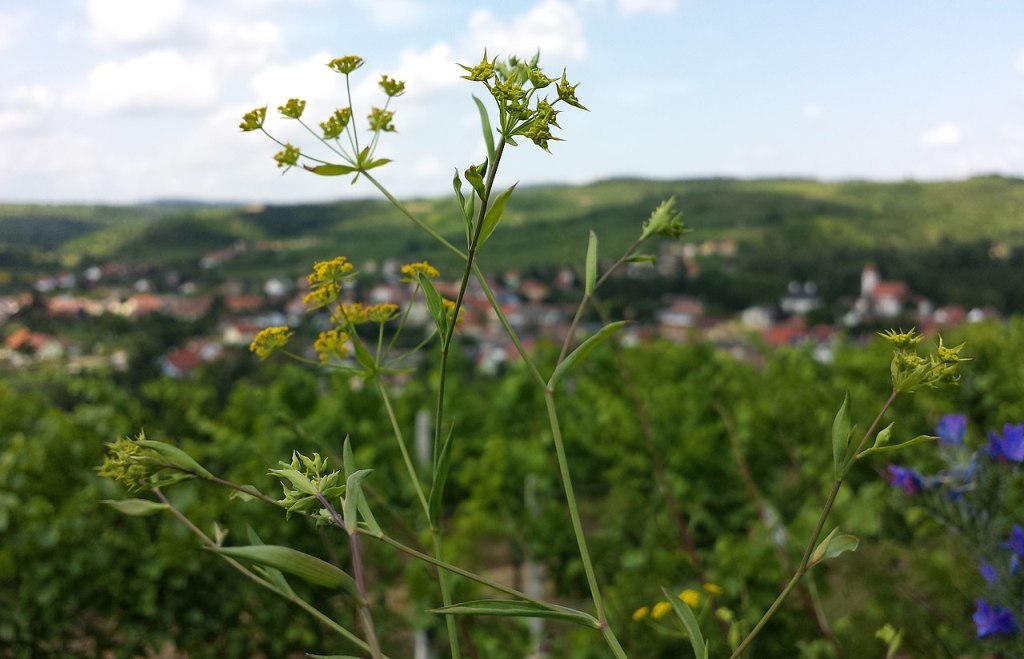
Bupleurum falcatum or Sickle-leaved Hare’s-ear
A Neophyte. This biennial or short-lived perennial herb has been recorded in hedge banks and field-borders, on ditch banks and on roadside verges, but only recently in the latter habitat.
Leaves and young shoots – cooked. The new growth in spring and autumn is used. It is a good source of rutin.
There are lots of uses according to PFAF:
- A paste of the plant is applied to boils.
- The juice of the roots, mixed with the juice of Centella asiatica, is used in the treatment of liver diseases. This species is closely related to B. chinense and quite possibly has the same uses. It is certainly worthy of some research. The uses of B. chinense are as follows:- Bei chai hu root has been used in traditional Chinese medicine for at least 2,000 years.
- It is a bitter herb that is used to harmonize the body, balancing the different organs and energies within the body.
- It strengthens the digestive tract, acts as a tonic for the liver and circulatory system, lowers fevers and has anti-viral effects.
- It is taken internally in the treatment of malaria, blackwater fever, uterine and rectal prolapse, haemorrhoids, sluggish liver, menstrual disorders, abdominal bloating etc.
- The root contains saikosides. These saponin-like substances have been shown to protect the liver from toxicity whilst also strengthening its function, even in people with immune system disorders.
- These saikosides also stimulate the body’s production of corticosteroids and increase their anti-inflammatory affect.
- The plant is often used in preparations with other herbs to treat the side effects of steroids.
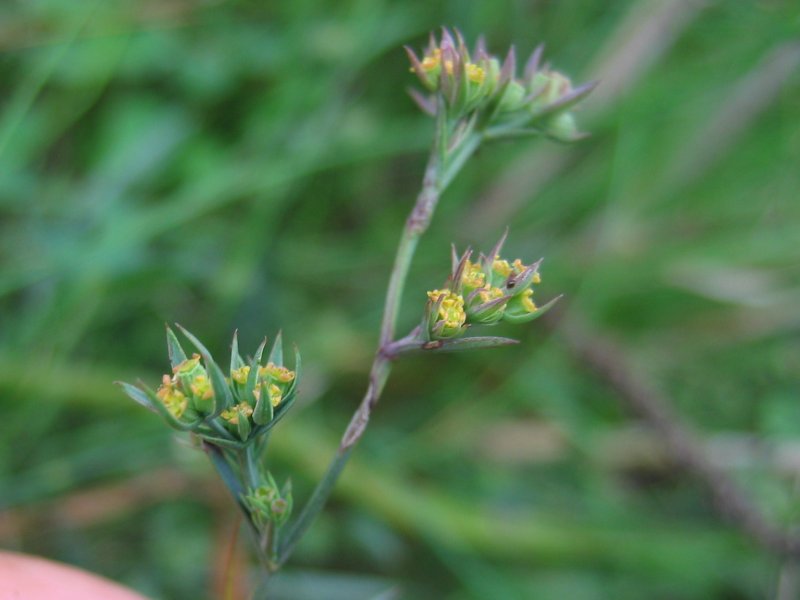
B. tenuissimum or Slender Hare’s-ear
This slender, often diminutive, annual is primarily a colonist of thinly vegetated or disturbed coastal sites, including coastal banks, sea walls, drained estuarine marshes and the margins of brackish ditches.
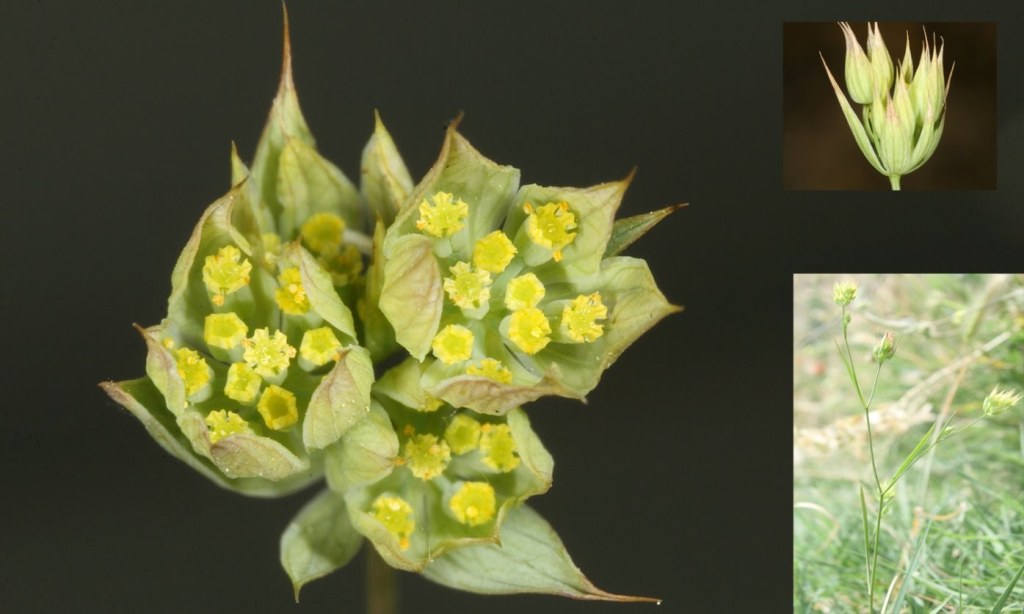
B. baldense or Small Hare’s ear
This diminutive annual is found in rabbit-grazed coastal grassland over calcareous substrates.
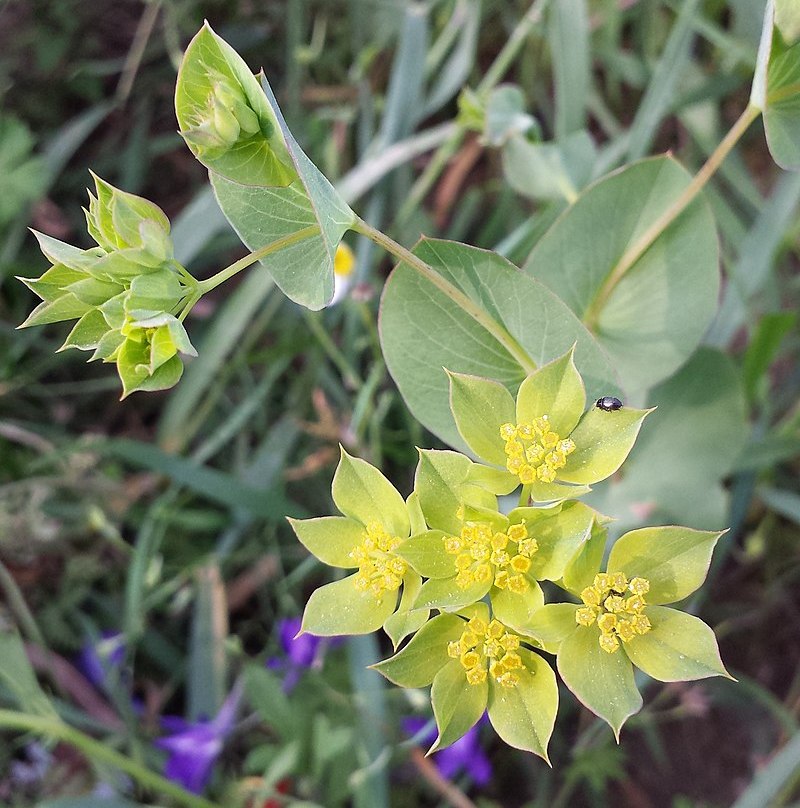
B. rotundifolium or Hare’s ear and Thorow-wax
An Archaeophyte. This annual was formerly an arable weed of chalk and limestone soils, but it is now a rare bird-seed casual.
Leaves – raw or cooked. Added to salads or used as a pot-herb. The leaves are also used as a spice.
Trinia glauca or Honewort
This monocarpic, dioecious perennial herb is restricted to dry limestone sites, typically occurring in short-grazed, open, species-rich turf on S.-facing slopes.
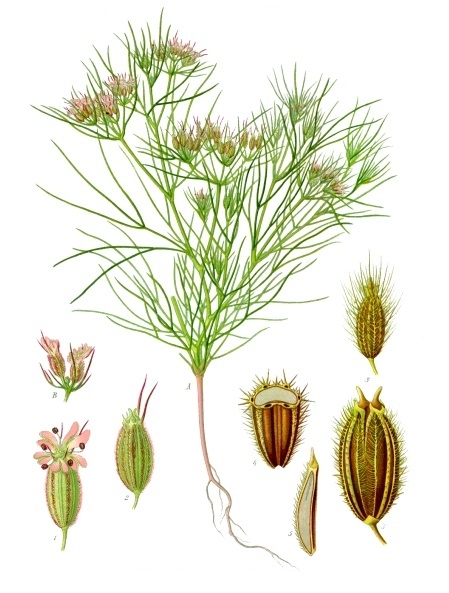
Cuminum cymimum or Cumin
A casual, neophyte herb. An annual which occurs on rubbish tips and waste ground, arising from bird-seed and food refuse.
Cumin seed is used as a spice for its distinctive flavor and aroma. Cumin can be found in some cheeses, such as Leyden cheese, and in some traditional breads from France. Cumin can be an ingredient in chili powder (often Tex-Mex or Mexican-style) and is found in achiote blends, adobos, sofrito, garam masala, curry powder, and bahaarat, and is used to flavor numerous commercial food products. In South Asian cooking it is often combined with coriander seeds in a powdered mixture called dhana jeera.
Cumin can be used ground or as whole seeds. It imparts an earthy, warming and aromatic character to food, making it a staple in certain stews and soups, as well as spiced gravies such as curry and chili. It is also used as an ingredient in some pickles and pastries.
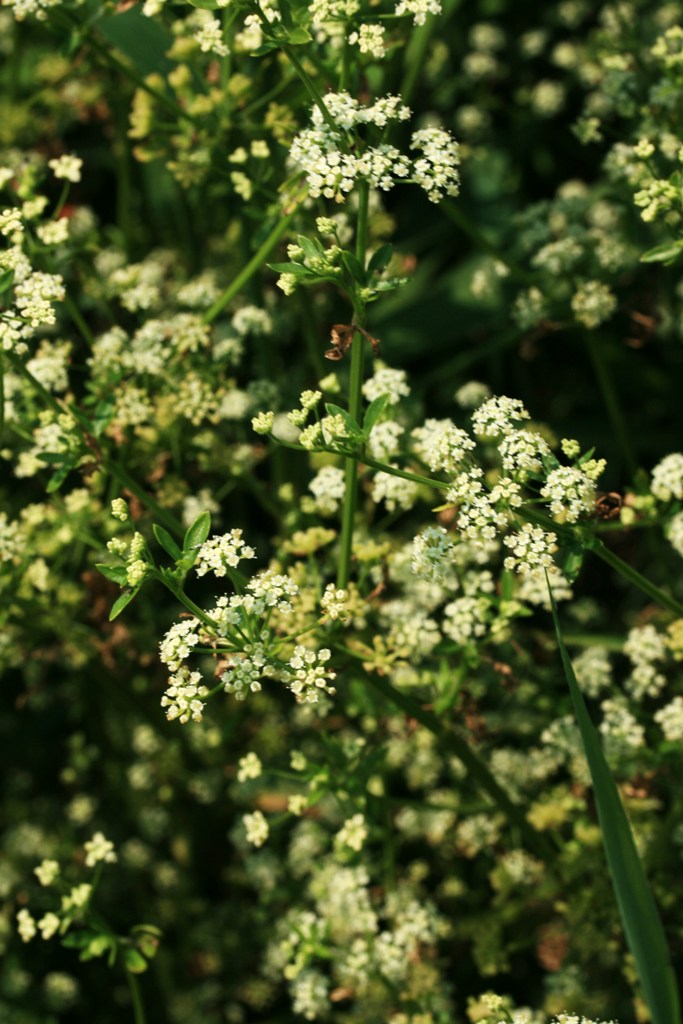
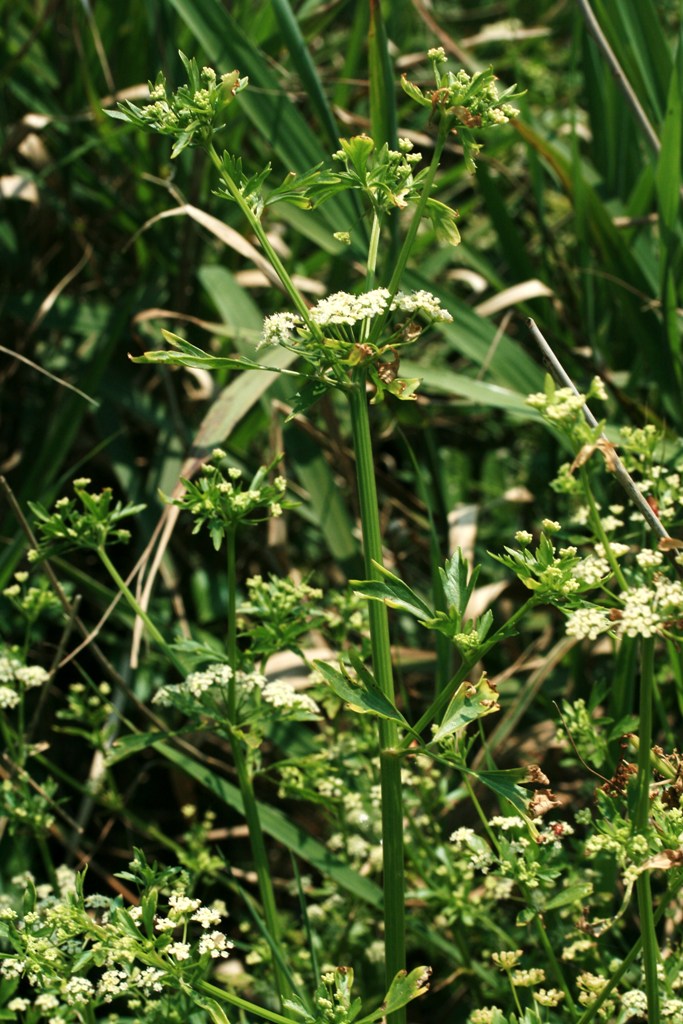
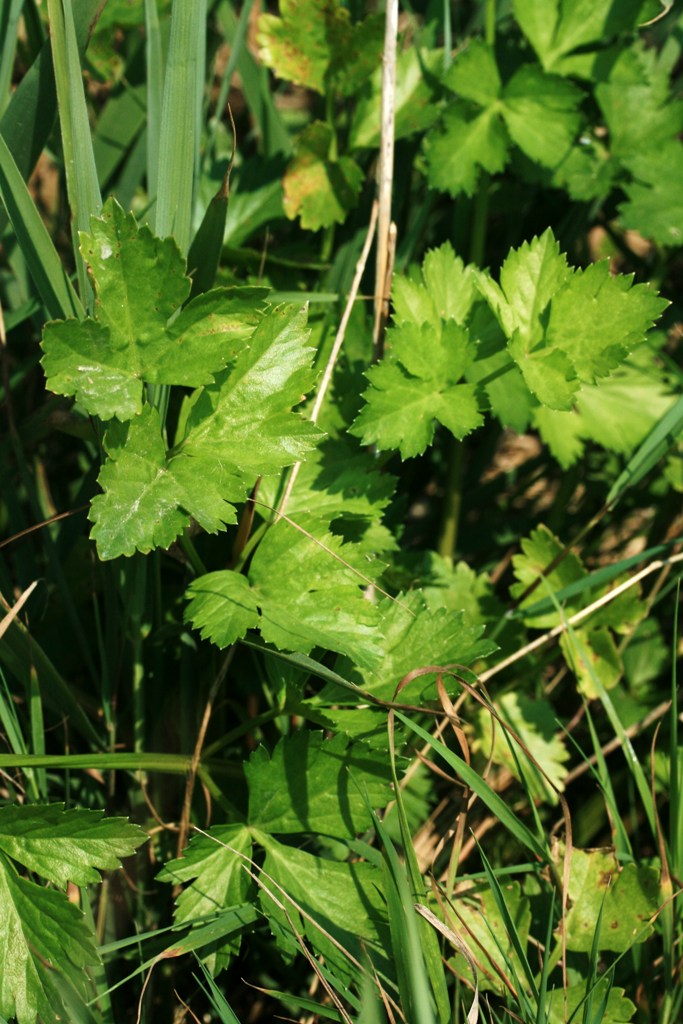
Apium graveolens or Wild Celery
A biennial or monocarpic perennial herb found on sea-walls, beside brackish ditches, on tidal river banks and drift lines, and the uppermost parts of saltmarshes.
Edible Use:
Use the dried leaves (dry for 3 weeks) in soup or sparingly fresh in salads Richard Mabey in ‘Food for Free’
Wild celery has a long history of medicinal and food use. it is an aromatic bitter tonic herb that reduces blood pressure, relieves indigestion, stimulates the uterus and is anti-inflammatory. See for more uses here.
Parts used Fruits, fresh or dried. All other parts should be fresh, or as a specific tincture Action: Diuretic and urinary antiseptic. Antirheumatic. Uses: Rheumatism. Arthritis. Gout. Inflammation of urinary tract.
Three former Apium spp. are now under the new genus called Helosciadium:
Helosciadium repens or Creeping Marshwort
A slender creeping perennial herb of winter-flooded grassland subject to falling water levels in spring and summer, leaving areas of bare damp mud and short sparse vegetation.
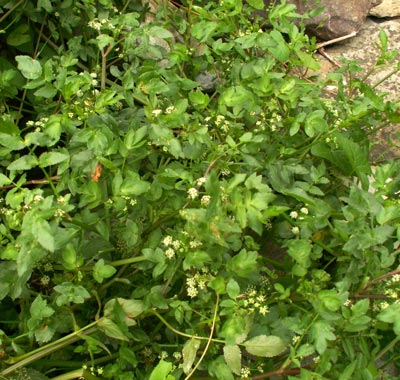
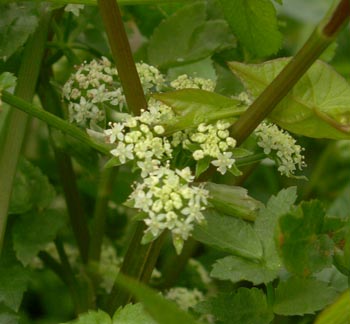
H. nodiflorum or Fool’s -water-cress (in habitat and close up from Wikipedia Commons)
H. nodiflorum or Fool’s -water-cress
A perennial herb, found in shallow water in streams, ditches, swamps and marshes, and on seasonally exposed mud at the edges of ponds, lakes, rivers and canals, sometimes scrambling into nearby vegetation. It is characteristic of nutrient-enriched sites and is very palatable to cattle, which reduce its extent in grazed sites.
This is not a poisonous plant, but it could be easily confused with the allegedly poisonous lesser water parsnip – Berula erecta.
Helosciadium inundatum or Lesser Marshwort
A perennial herb of permanent shallow water in streams, ditches, ponds, canals and backwaters, and in sites which are subject to periodic desiccation, such as the edges of lakes, pools, reservoirs and dune-slacks. It is confined to oligotrophic or mesotrophic habitats, and most sites are base-poor.
Trachyspermum ammi or Ajowan
An annual herb, found on refuse tips and waste ground, where it originates from bird-seed and from its use as a spice. A Neophyte in Britain.
The fruits are rarely eaten raw; they are commonly dry-roasted or fried in ghee (clarified butter).
- The seeds are used in specific types of breads, such as naans and parathas.
- The seeds can also be used as a mouth freshener when mixed with lemon juice and black pepper and then dried.
- Or, the seeds can simply be used as an ingredient in hot tea.
Ajwain is used in traditional medicine practices, such as Ayurveda, in herbal blends in the belief it can treat various disorders.
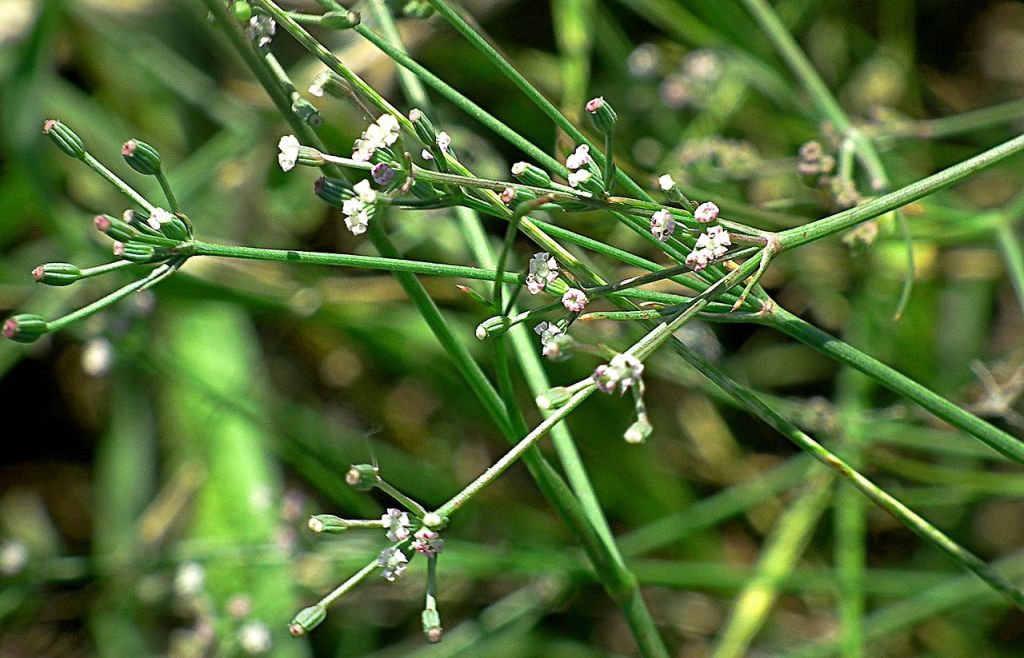
Sison segetum or Corn Parsley
This slender biennial herb of well-drained calcareous soils on clay or chalk is found on arable field margins, on grassy banks, roadsides, railway banks, riverbanks, by sea-walls, in drained estuarine marshes, on rough waste ground and occasionally as a garden weed.
It is an aromatic herb, used for culinary purposes.
Sison amomum or Stone Parsley
A biennial herb of sticky clay and better drained neutral to calcareous soils, found mainly in hedgerows, on banks, rough scrubby grassland, waysides and disturbed waste ground.
Root is cooked. It is said to taste like celery. The aromatic leaves and seed are used as a condiment. The fresh seeds have a nauseous smell.
Carminative, diaphoretic, diuretic
Ridolfia segetum or False Fennel
Is not native: highly rated by Sarah Raven for its useful flowers for flower arranging as well as a good bee plant.
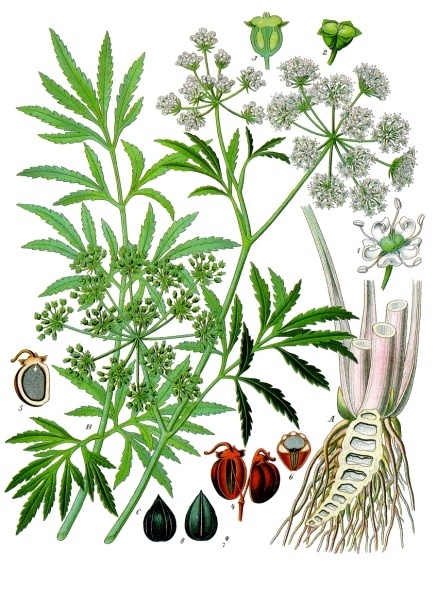
Cicuta virosa or Cowbane
This perennial herb grows in shallow water on the margins of standing or slowly flowing water, including lakes, ponds, rivers, streams, ditches and canals, or in deeper water on floating mats of vegetation. It also occurs in tall-herb fen, in marshy pasture and on damp mud.
Ammi majus or Bullwort
An annual herb, found on waste ground, in gardens, on arable headlands, and locally in parkland and roadsides. It is sometimes sown in wild-flower seed mixes, was formerly a wool alien, but is primarily a birdseed alien which is usually casual.
Is not native but grown as an ornamental/cutflower
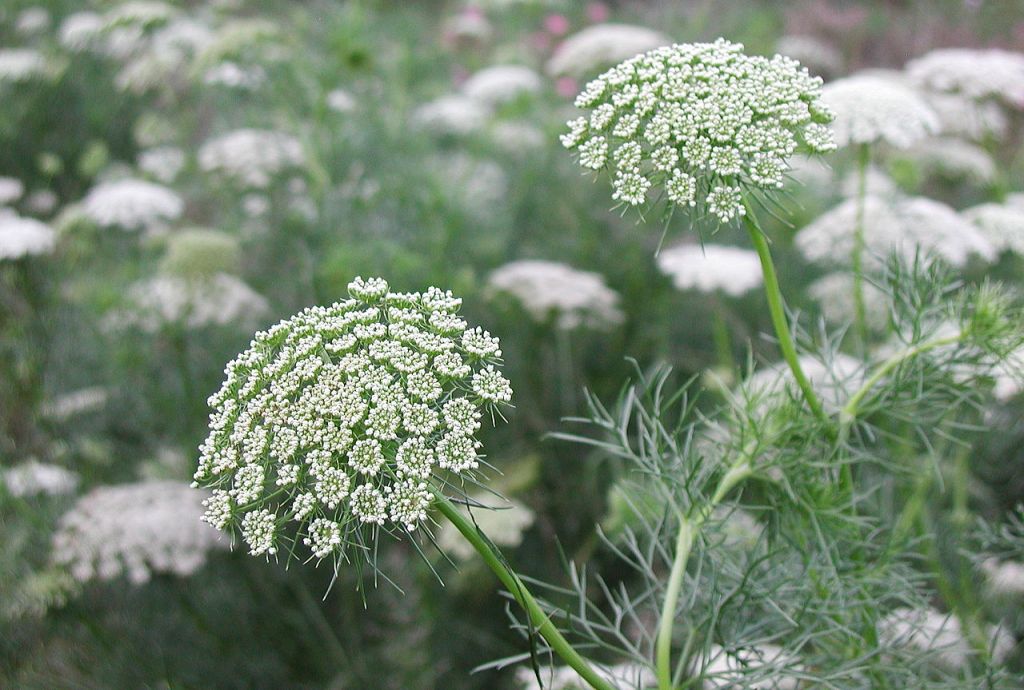
Visnaga daucoides or Toothpick-plant
An annual herb of cultivated ground in fields and gardens, and on refuse tips and waste land. It arises most frequently from birdseed and as a grain contaminant, and formerly from wool shoddy. (Neophyte)
This has been cultivated since earliest times for medicine. More recently, it has been exploited as a drug for use in angina and asthma.
The fruiting pedicels (ie the rays of the umbel) are sold in Egyptian markets as tooth picks.
Falcaria vulgaris or Longleaf
A rhizomatous perennial herb, found in a wide variety of habitats especially on calcareous soils, including pasture, arable fields, roadsides, cliff-top grassland, scrub, chalk quarries, gravel-pits, railway ballast, riverbanks and waste ground. Viable seed is only produced in warm summers in Britain and large colonies probably result from rhizomatous growth.
Introduced in 1726 as a garden plant!
Its use as an alternative medicine may offer several advantages, especially in the treatment of stomach and skin ulcers, diabetes, infections, and liver and kidney disorders.
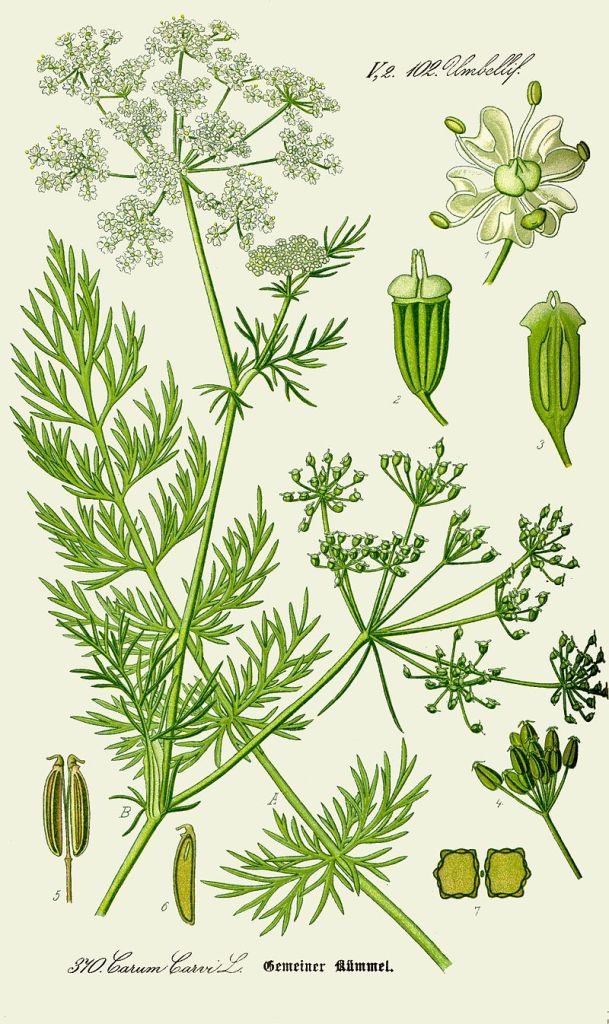
Carum carvi or Caraway
A monocarpic perennial herb, found naturalized in meadows, on sand dunes, roadsides and railway banks, and as a casual in waste places and on rubbish tips. (Not Native)
It is by far the most popular of the Umbeliferous carminatives in Central and Eastern Europe. I would say that it loses favour to Fennel and Aniseed as you travel west. Large amounts of the fruits are used, especially for baked goods but also for charcuterie and savoury dishes like sauerkraut. It flavours various liquers like Kummel. The plant, which is mentioned in the Bible, has been known medicinally for at least 5000 years. It came to Western Europe, along with its name kharwayia from the great Arab medical tradition of the 10th-12th centuries.
Pigeon-fanciers will keep their birds faithful if they include a bit of caraway in the feed.
Action: Antispasmodic and carminative. Expectorant. Antimicrobial. Galactagogue. Said to be emmenagogue. Uses Flatulent dyspepsia. Intestinal colic. Anorexia. Respiratory tract infections; laryngitis (gargle). Said to be useful for painful periods.
Trocdaris verticillata or Whorled caraway
A perennial, calcifugous herb of marshes, streamsides, damp meadows, rushy pastures and on wet hillsides with a pronounced soligenous influence. Especially typical of rush-pastures and mires dominated by Molinia caerulea.
Selinum carvifolia or Cambridge Milk-parsley
As its common name in English suggests, Selinum carvifolia has a somewhat parsley-like scent if crushed, although unlike Caraway (from which its specific name derives) it is not a highly aromatic Umbellifer. Records of its having been used as a food, seasoning or medicinal plant are hard to come by, but neither is it listed as a poisonous plant.
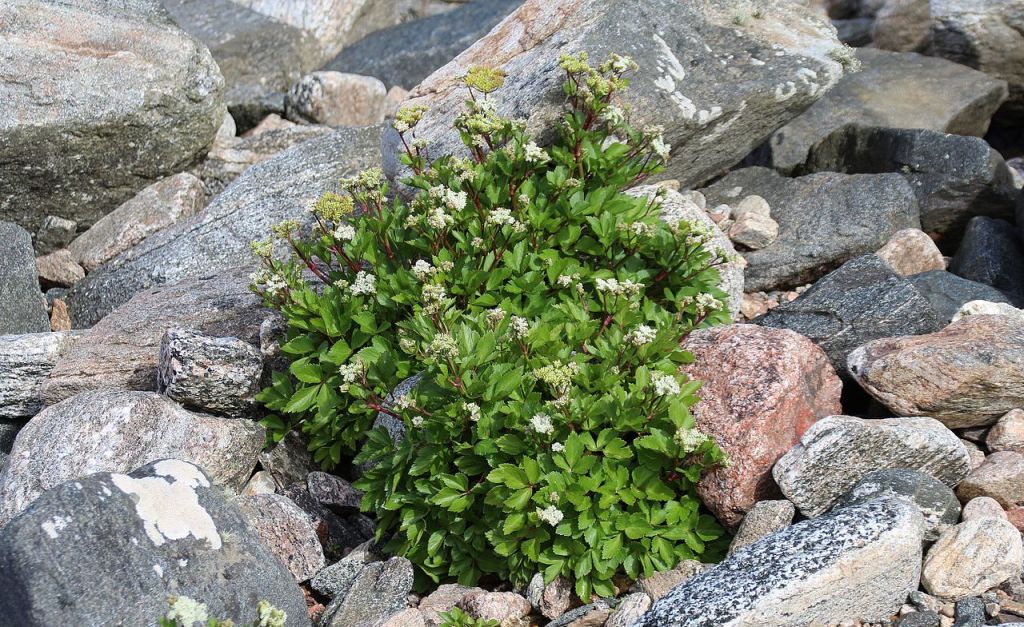
Ligusticum scoticum or Scots Lovage
A perennial herb of coastal rock crevices and free-draining skeletal soils by the sea. Its habitats include sea-cliffs, rocky shores and platforms, spray-drenched shingle, stabilized sand dunes and stone sea-defence walls. Its palatability to sheep limits its spread into coastal grasslands. The seeds float and retain some viability even after a year in sea water.
The flavour of both Lovages the Scots Lovage as well as the cultivated Levisticum officinale is curious (R. Mabey), basically resembling celery, but having quite strong yeasty overtones. Because of this lovage has been used to add body to the flavour of soups and casseroles when meat is short.
On account of its vitamin C content antiscorbutic, carminative and diuretic, mostly from the volatile oil which it contains.
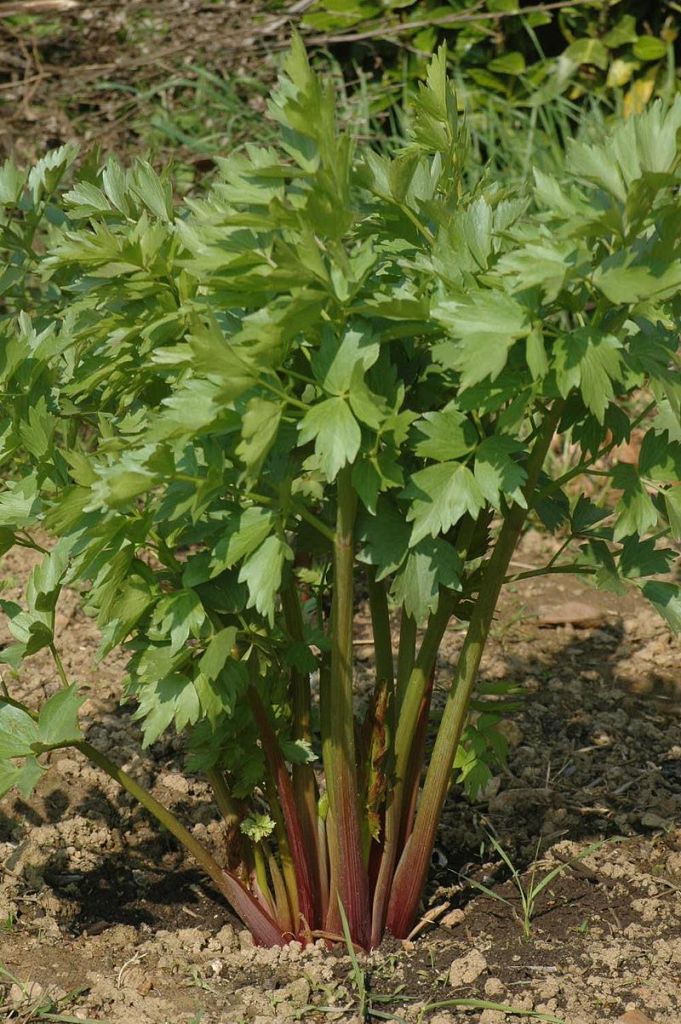
Levisticum officinale or Lovage
A tall clump-forming perennial, much grown as a culinary herb and found naturalized on rough ground and by walls, paths and roadsides. It also occurs as a relic of cultivation. Not Native.
Action: Stomachic, carminative and cholagogue. Diuretic. Antidiaphoretic. Mild expectorant. Emmenagogue. Uses: In soup (it has an unusual flavour and should be used sparingly). Said to be useful for rheumatism and painful periods. The fruit has been used for migraine. Caution: not to be taken during pregnancy, nor where there is kidney impairment or disease.

Angelica sylvestris or Wild Angelica
A perennial herb, occurring on base-rich soils in a wide variety of habitats, including damp woods and carr, damp neutral grassland, marshes, mires, swamps and tall-herb fens, river- and ditch-banks, sea-cliffs, ungrazed montane grassland and mountain ledges.
This is a close relative of garden angelica or A. archangelica. It is thinner and more bitter than the cultivated variety, but good enough as a flavouring. Slice the stems into 4inch lengths, scrape off any tough outside fibres, and then simmer in sugar syrup until tender. Drain off the syrup, strew crushed sugar over the stems and simmer again until this thicker syrup is clear. Lift the stems on to a tray, boil up the syrup to sugar point, pour over the angelica; then drain, boil and pour again, repeating the cycle until the stems can be dried into firm, crystallised lengths.
The leaves make a reasonable carminative and stomachic drink, the root and fruit are stimulant and antispasmodic. The pulverised fruits have been used to get rid of and deter nits from the heads of children. The volatile oil content is considerably less than the following species, but that can be an advantage when a gentler remedy is needed, for instance with children.
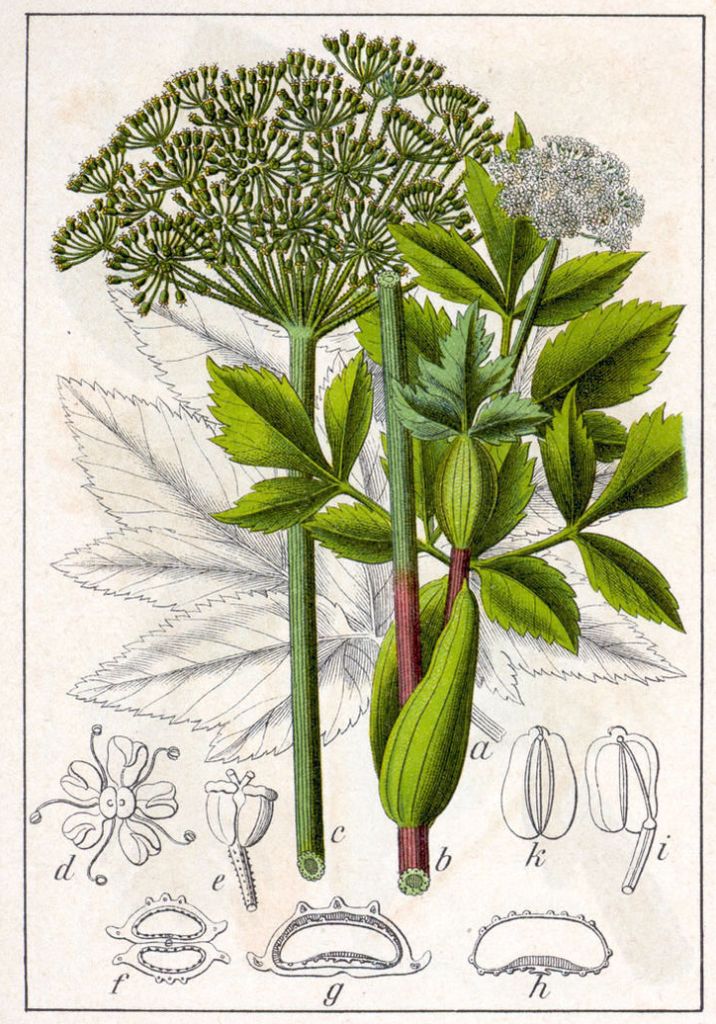
Angelica archangelica or Garden Angelica or Archangelica
A robust monocarpic perennial herb that, as a presumed native plant, occurs as a sporadic colonist of beaches in Shetland. However, it occurs much more widely as a naturalized garden escape on riversides and by canals, roadsides and in waste places.
It is used to flavor liqueurs or aquavits, (e.g., Chartreuse, Bénédictine, Vermouth, and Dubonnet), omelettes and trout, and as jam. The long bright-green stems are also candied and used as food decoration
Action: Aromatic bitter. Gastric stimulant. Antispasmodic and carminative. Diaphoretic. Antiseptic. Said to be diuretic Uses: flatulent dyspepsia associated with hypoacidity. Anorexia nervosa. Bronchial catarrh. Of great value in asthma and some types of migraine. Peripheral vascular disorders. The leaf is carminative and anti-inflammatory and is made into compresses to relieve thoracic pain.
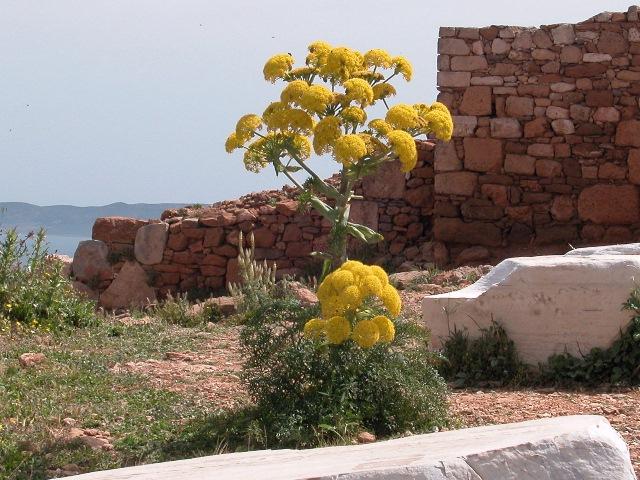
Ferula communis or Giant Fennel
A large perennial herb, naturalized on a few roadsides and in a park. Populations are often long-lived, recorded over several decades. Neophyte.
In Sardinia two different chemotypes of Ferula communis have been identified: poisonous (especially to animals like sheep, goats, cattle, and horses) and non-poisonous.
Since antiquity, the resin of Ferula species has been used for medicinal purposes.
Used ocasionally as an ornamental in gardens
In the past, rods and whips for disciplinary purposes were made from the stalk of Ferula. From this, we have latin ferire (to hit), and also the Swedish färla (disciplinary tool used in schools in the past).
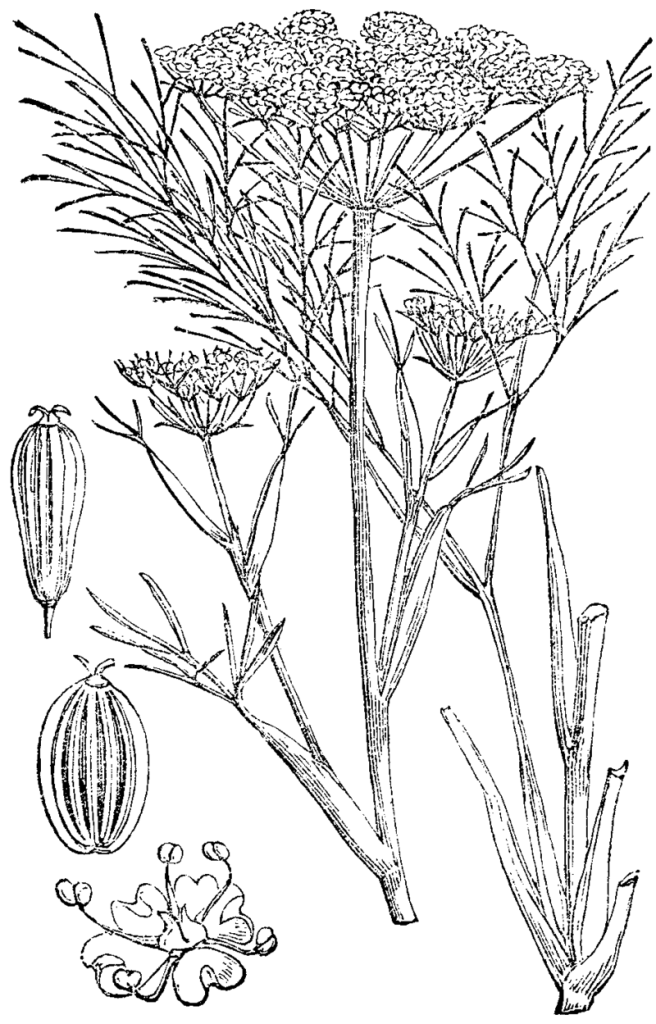
Peucedanum officinale or Hog’s Fennel
A perennial herb of coastal grassland occurring in rough grassland and scrubby places adjoining upper saltmarsh or brackish grazing marsh, on creek sides and on sea-walls and embankments; also on waste ground and, rarely, on roadsides.
This is a very rare native. One cannot be sure whether this was the peukedanos that Dioscorides valued so highly. The strong sulphurous contents give it expectorant, antispasmodic and diaphoretic properties. Whether it has the claimed antimicrobial activity ascribed to it has not been put to the test in modern times.
Thysselinum palustre or Milk-parsley
A biennial or short-lived perennial herb of permanently damp peat, often in sites flooded in winter. It is most characteristic of tall-herb fen, being found in both cut and uncut stands. It can survive in fen scrub and alder-carr, and it occurs rarely in marshes and damp pasture.
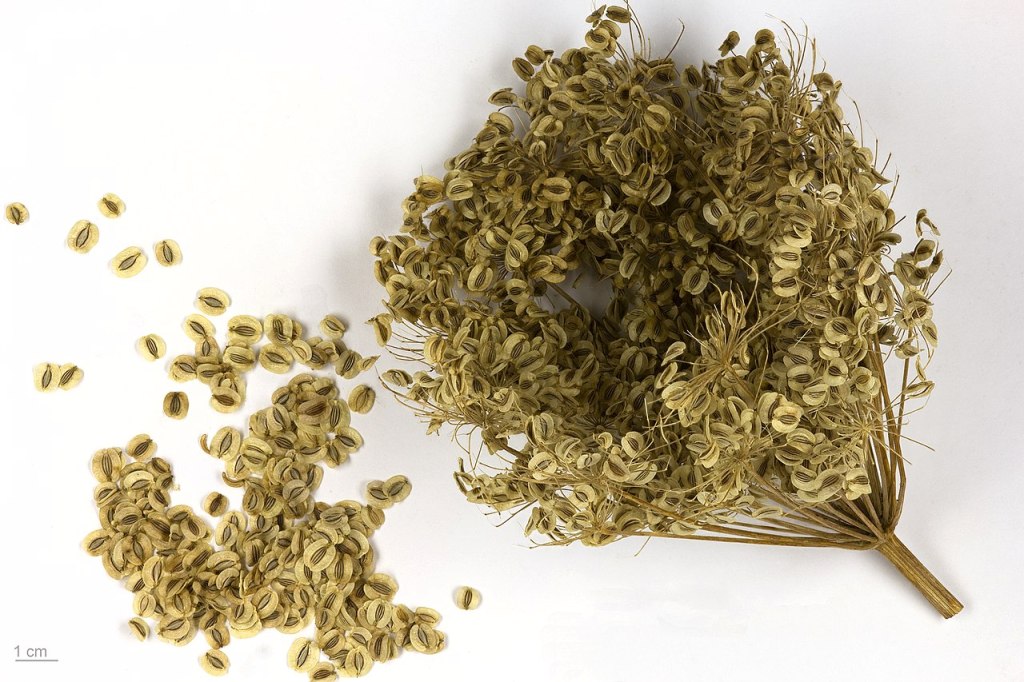
Imperatoria ostruthium or Masterwort & Imperatoria
A perennial herb naturalized in moist or damp grassy areas, including marshy pasture, on hillsides and by streams and rivers, and sometimes established around farm buildings. An archaeophyte in Britain and Ireland.
- Leaves can be cooked
- Used as a potherb or as a flavouring
- The aromatic roots can be used as a flavouring. They are said to taste hotter than pepper.
- A particularly popular drink is made from the fermented roots.
Masterwort is little used in modern herbalism, but it may well be a herb that bears further investigation (see more on PFAF website)!
This was a most important medicinal plant in Gerard’s day and was cultivated on some scale. The heyday use of this plant has retired from these parts but it and several others of the 170 species in this genus are used in Central and Eastern Europe and also in Africa and India. What was it used for? Chronic bronchial catarrh. It is also aperitif and stomachic (an aromatic bitter rather similar to Angelica). It was considered useful as an anti-venom, an indication still recognised in Switzerland today.
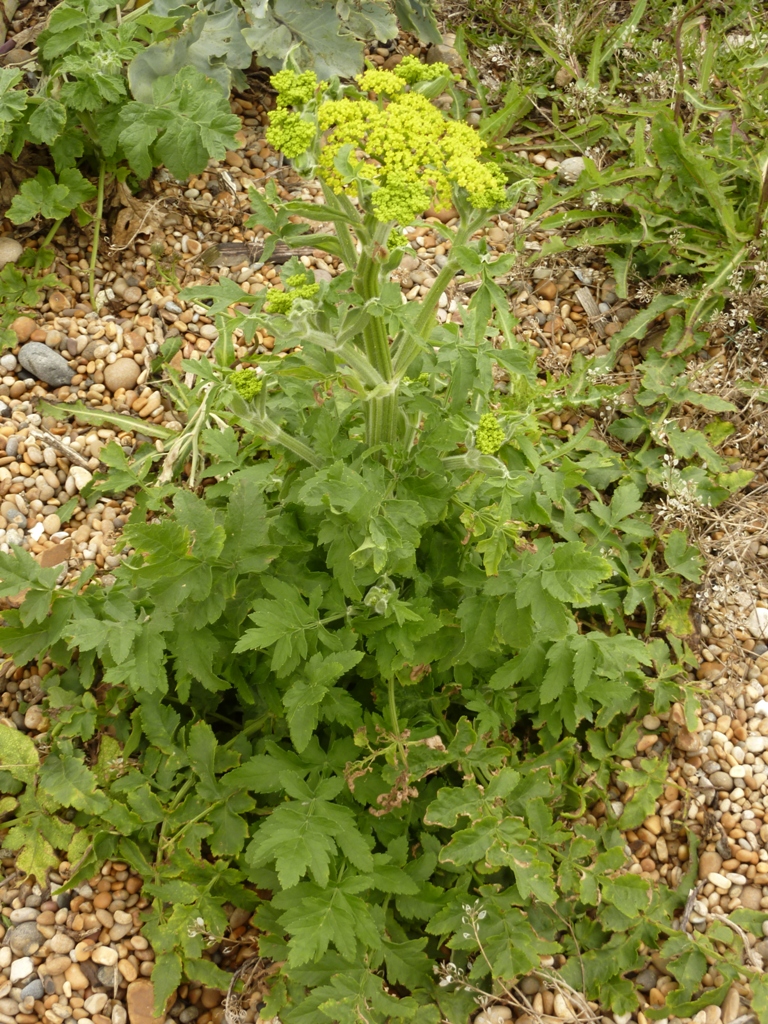
Pastinaca sativa ssp. sylvestris or Wild Parsnip
The native subspecies of this biennial herb, subsp. sylvestris, occurs in neutral and calcareous grassland, especially in chalk and limestone districts. It is found in rank swards on downland, on roadsides, railway banks, and rough and uncultivated land.
This is the wild, non edible form of Pastinaca sativa or Parsnip. In Europe, various subspecies have been named based on characteristics such as the hairiness of the leaves, the extent to which the stems are angled or rounded, and the size and shape of the terminal umbel.
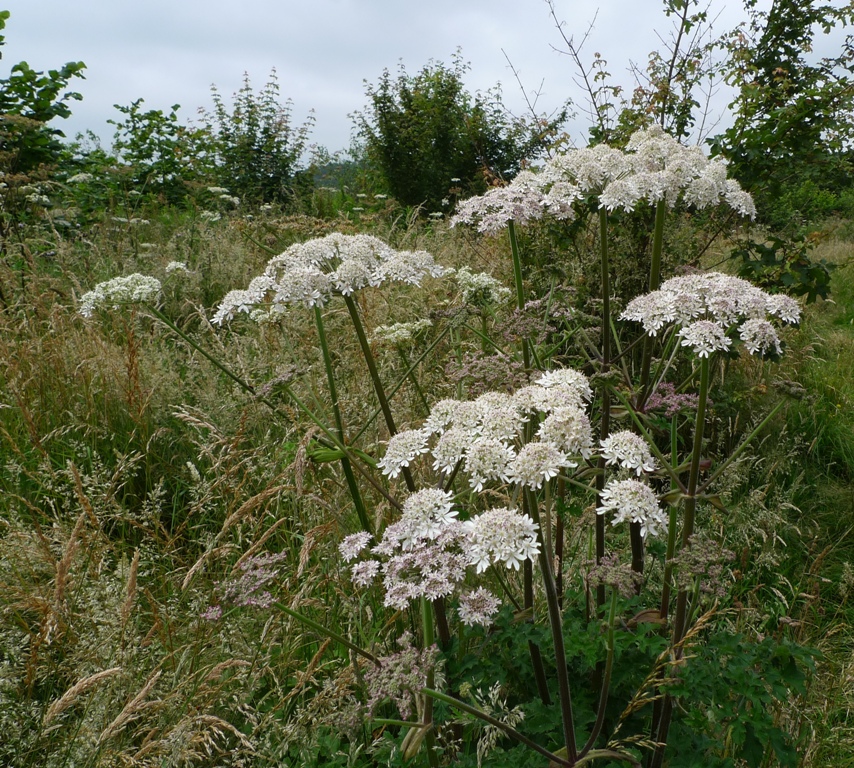
Heracleum spondylium or Hogweed or Cow parsnip
A robust perennial herb of dry or moist, neutral to calcareous soils. It has a wide habitat range, including rough and disturbed grassland, especially on roadsides and trackways, woodland rides, scrub, riverbanks, stabilized dunes, coastal cliffs, montane tall-herb vegetation and waste ground.
The young shoots are marvellously fleshy. (R. Mabey) Pigs do like the leaves and with the fleshy sprouting shoots reminiscent of asparagus, why shouldn’t they? The people of the Baltic use it much more than we: in Poland and Lithuania they make a potent fermented soup from the leaves and fruit called bartszcz or borscht.
The stem and leaf hairs are capable of producing a very nasty contact dermatitis with the possibility of subsequent photosensitivity. At its worse, this can lead to permanent purplish discoloration of the skin.
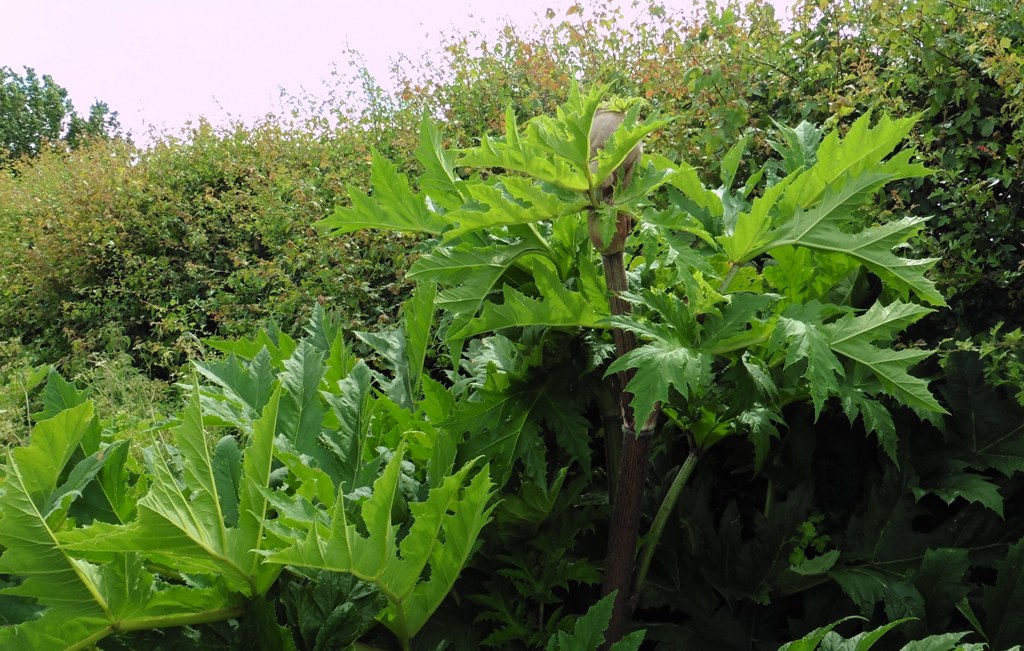
H. mantegazzianum or Giant Hogweed
A massive, often monocarpic perennial herb, mainly naturalized along rivers and streamsides but also found in derelict gardens, woodland clearings, neglected urban places, waste ground, refuse tips, roadsides, abandoned pastures and arable field margins. It spreads prolifically by seed, forming very large colonies where left to regenerate.
H. mantegazzianum was introduced to British gardens as a monumental curiosity by 1817. It was then deliberately planted by rivers and ponds and was first recorded in the wild in 1828 (Shelford, Cambridgeshire).
(NN or Neophyte). The sap of giant hogweed is phototoxic and causes phytophotodermatitis in humans, resulting in blisters and scars.
Tordylium maximum or Hartwort
Neophyte and rare annual or biennial herb of neutral grassland and in grassy thorn scrub, on clayey or alluvial soils.
Torilis spp. or Hedge-parsleys
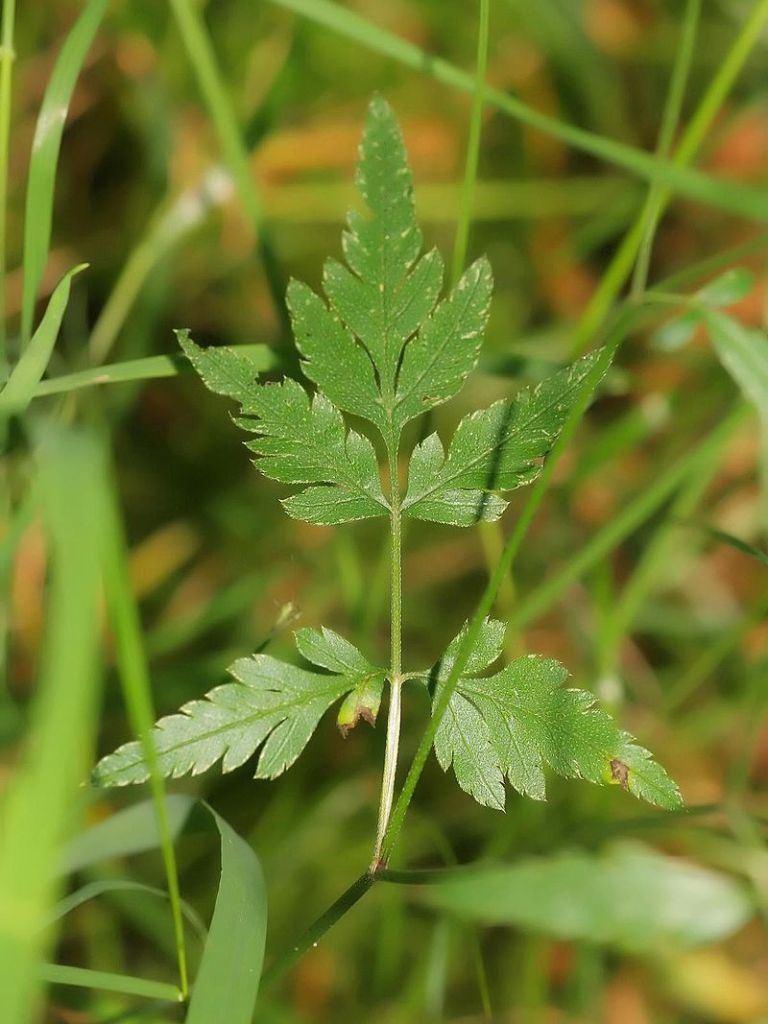
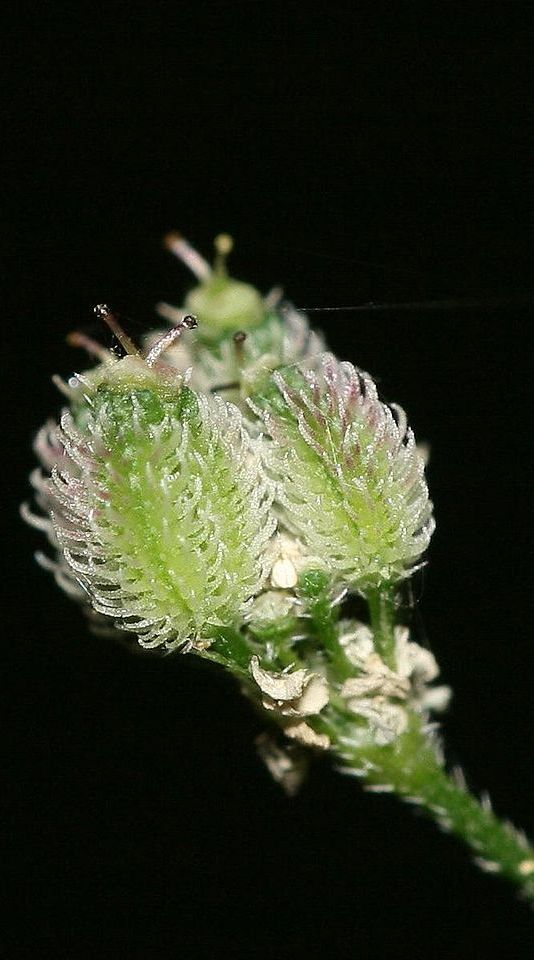
Torilis japonica or Upright Hedge Parsley (pictures by Kristian Peters in Wikipedia)
Torilis japonica or Upright Hedge Parsley
An annual, or rarely biennial, herb of dry neutral and basic soil, found in woodland margins, hedgerows, rough and rank grassland, and on roadside verges.
- Leaves – cooked
- Root – peeled and eaten raw
- Although we have no record of the seed being edible, there is a report that it contains 16 – 21% protein and 10 – 23% fat
The seed is anthelmintic, antifungal, antiviral, expectorant and tonic. It is used in Korea in the treatment of amnesia, pruritis, acidosis and scabies. The juice of the root is used in the treatment of indigestion.
T. nodosa or Knotted Hedge Parsley
An annual herb of dry, sparsely vegetated habitats, including open grassland, sunny banks, sea-walls, cliff-tops, arable fields, tracks, roadside verges, pavements and waste ground; occasionally in disused sand- and gravel-pits, and on refuse tips.
T. arvensis or Spreading Hedge Parsley
An archaeophyte and annual, rarely biennial, herb, almost exclusively found on arable land in autumn-sown cereals, but sometimes in other arable crops; also on waste and disturbed ground.
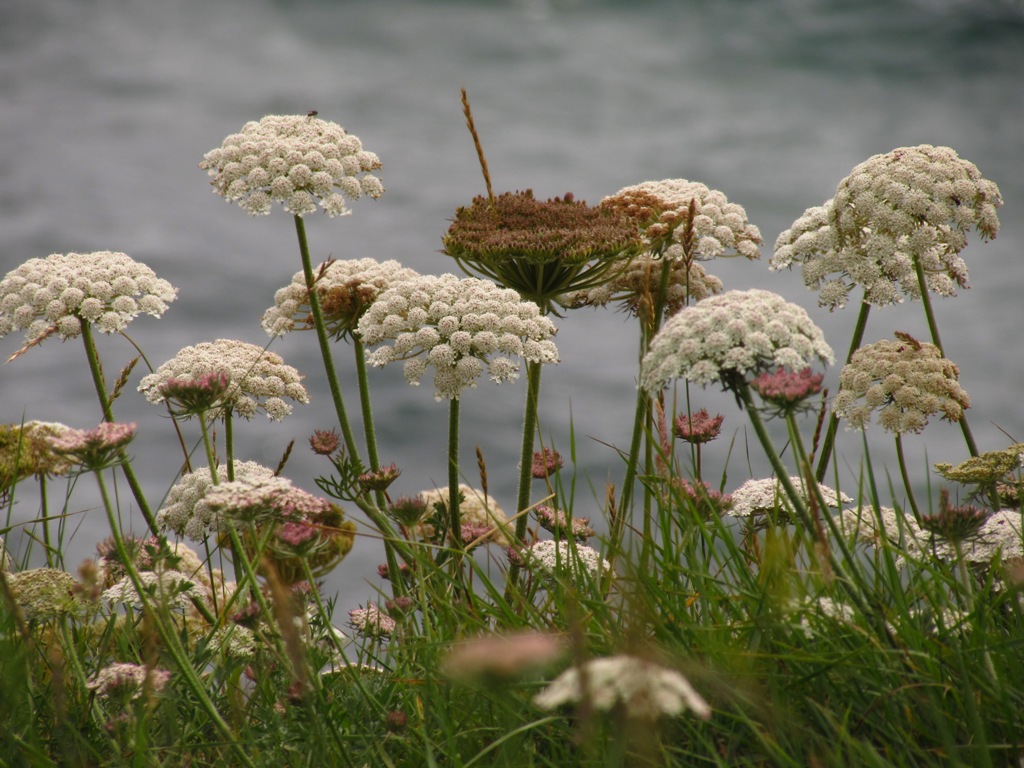
Daucus carota or Wild Carrot
- Daucus carota ssp. gummifer or Sea Carrot
- Daucus carota ssp. sativus or (Cultivated) Carrot
A biennial herb of fairly infertile, well-drained, often calcareous, soils. Its habitats include disturbed or open turf on chalk downs, rough grassland on roadsides, waysides and railway banks, quarries, chalk- and gravel-pits, and waste ground. In Scotland it is predominantly a coastal species. It is increasingly sown in wild-flower seed mixtures used to create ‘wildlife friendly’ grasslands on road verges and around arable fields.
Action: Diuretic. Antilithic. Antirheumatic. Carminative. Uses: Gout. Polymyalgia rheumatic (in combination with a number of other remedies). Urinary gravel. Cystitis.
D. c. ssp. sativus is the domesticated Carrot. The fleshy root of the cultivated carrot is a well-known and highly nutritious food.
It is also, but only if taken raw daily, a gentle remedy for threadworms in children. The leaves of the carrot contain porphoryns which tend to stimulate pituitary release of the gonadatrophic hormones. Wide medicinal uses are claimed but, in practice, it is employed as a remedy for a number of urinary conditions and for gout, for which it often does well with Celery seed.
The cultivated plant subsp. Sativus has been known for 2000 years and is derived from a Mediterranean ancestor and not from the native plant. Originally it contained anthocyanin pigments which made it the colour of beetroot. The colour was bred out in Holland in the 17th and 18th centuries.
Skin contact with the foliage of Daucus carota, especially wet foliage, can cause skin irritation. “Sensitized photosensitive persons may get an exact reproduction of the leaf on the skin by placing the leaf on the skin for a while, followed by exposure to sunshine.”]Contact with the cell sap of Queen Anne’s lace (Daucus carota) can cause skin irritation and blistering.
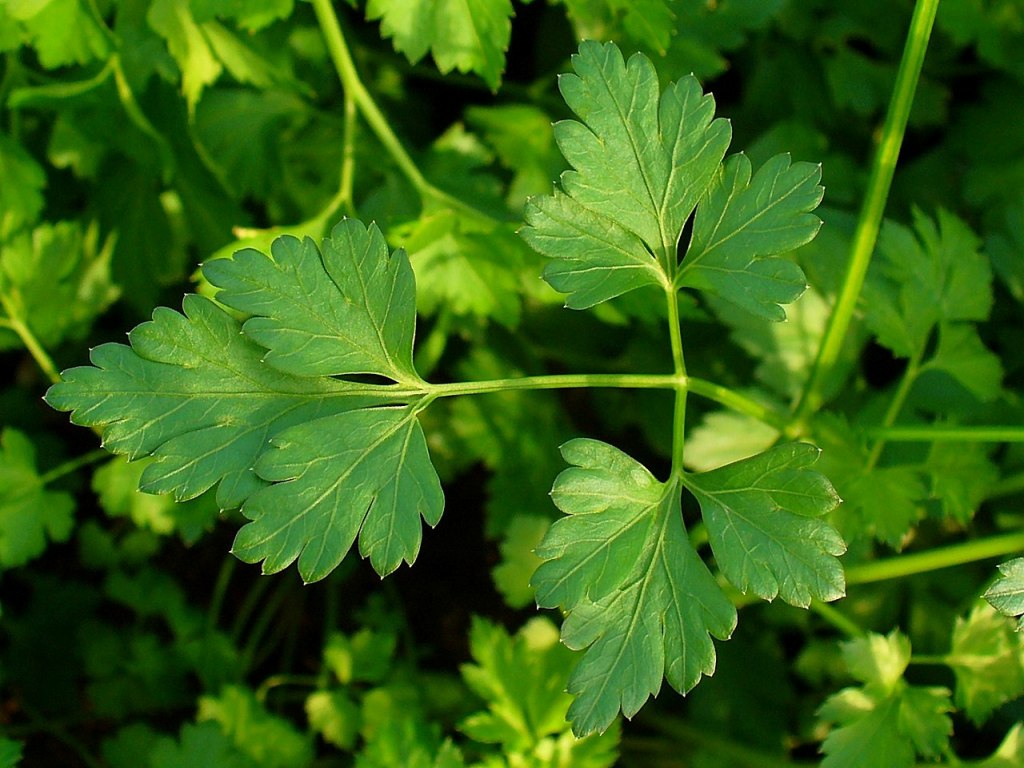
Petroselinum crispum or Garden Parsley
Not Native. Try frying your parsley for half a minute in hot oil and serve as vegetable. Extremely rich in Vit. C
Action: Diuretic. Emmenagogue. Anti-galactogenic. Antispasmodic. Stomachic: action on digestive tract with high mineral and vitamin content make it anti-anaemic. Antimicrobial. Uses: Dysmenorrhoea. Amenorrhoea. Dysuria. Cystitis. Chronic oedema of metabolic or cardiac origin. Anaemia. Flatulent dyspepsia. Nausea.
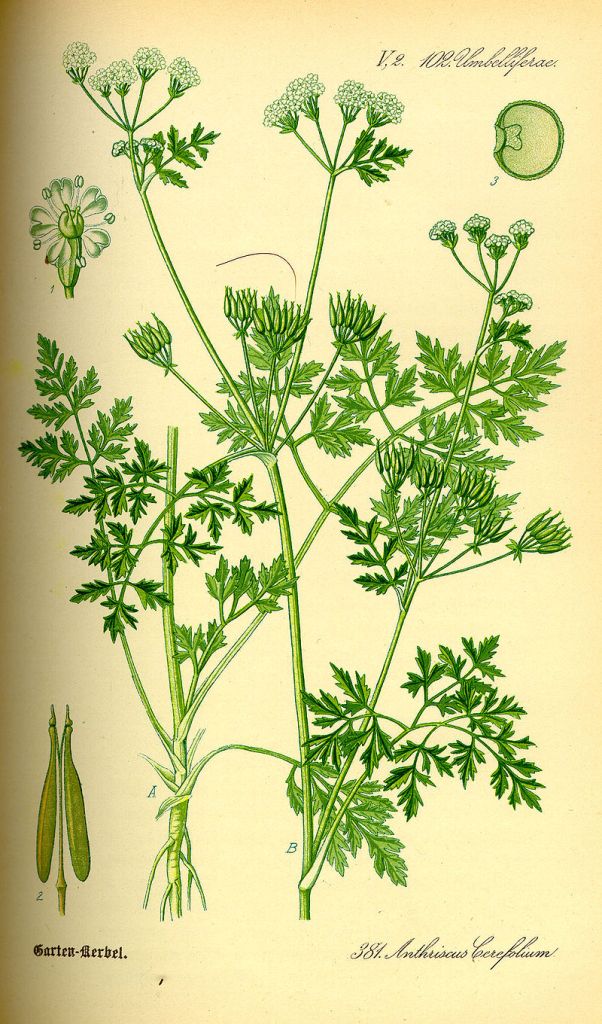
Anthriscus cerefolium or Garden Chervil
(NN)
Undervalued as a culinary herb (at least in Britain), it can improve almost any dish. I would say it is better used in combination with others. With Dill, for instance, (new potatoes), with Sweet Marjoram (scrambled eggs), with Basil (tomato dishes), with thyme (soups and stews). Grow it behind something which will give it shade in summer and full sun in winter.
Medicinally, it is said to be chloretic and, applied externally as a poultice to the breast, anti-galactogenic. In a number of instances I have winessed a simple infusion of the herb dry up the mother’s milk and bring back menstruation within a day or two.
